18 – Cable Car to the Car-less Village of Mürren in the Swiss Alps
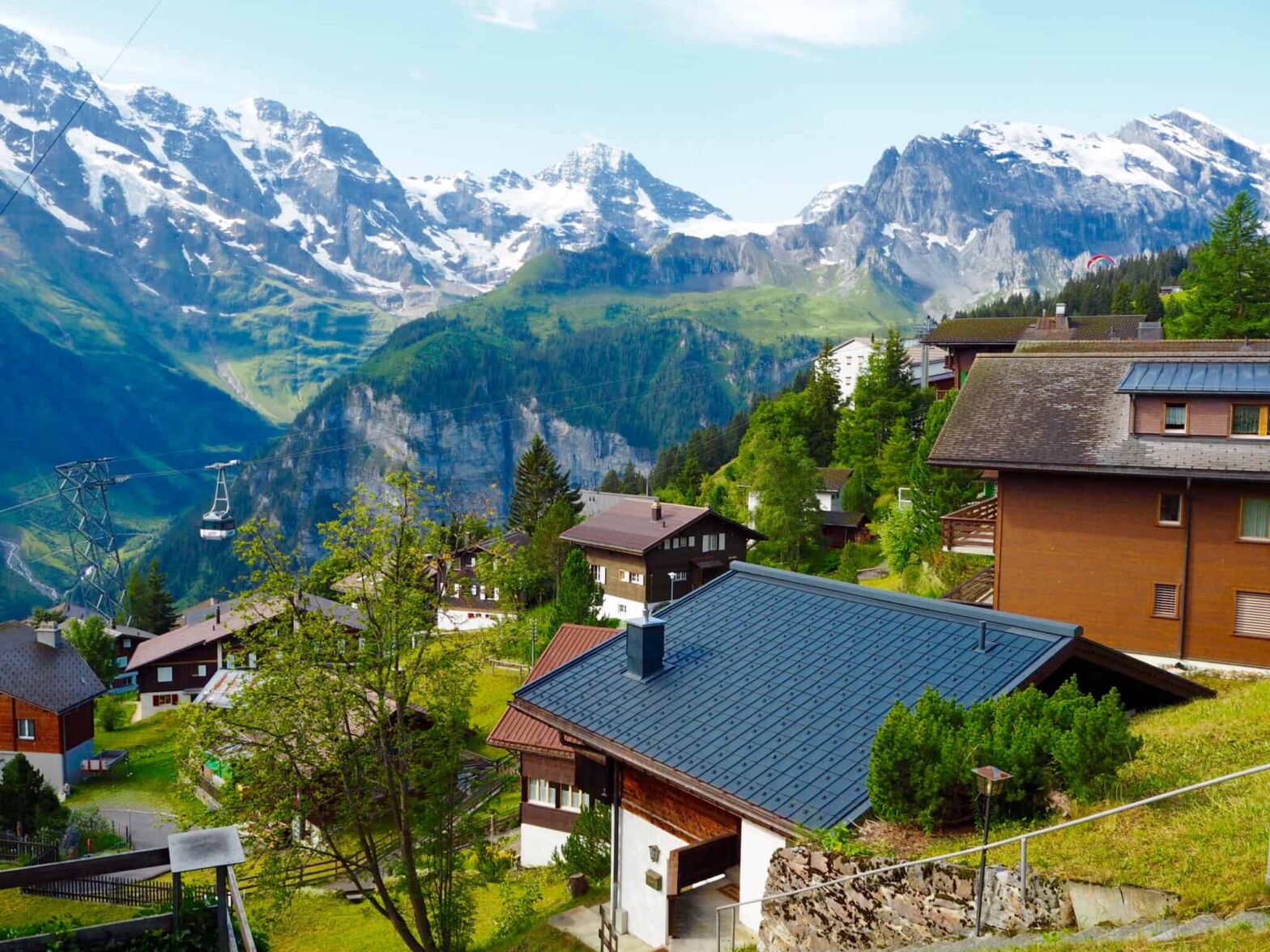
18 - Cable Car Ride to & Evening in the Alps Village of Mürren
On June 22, 2023, our Hiestand-Haston Heritage Tour group will take a scenic cable car ride up to the mountain village of Mürren.
And we will spend the night there!

Mürren is a traditional Walser (inhabitants in the Alps) mountain village in the Bernese Highlands of Switzerland, at an elevation of 5,374 ft above sea level and it cannot be reached by public road. It is also one of the popular tourist spots in Switzerland. The village features a view of the three towering mountains Eiger, Mönch, and Jungfrau. Mürren has a year-round population of 450.
Don't Miss Viewing this Webcam - in Real Time!
This webcam is placed in the Hotel Edelweiss in the village of Mürren, high in the Swiss Alps. The panorama shows the Bernese Alps as well as the lower village road of the carefree (and car-free) mountain village.
Don't worry, if you are afraid of heights (like I am) you don't have to do the scary stuff.
Share this with Hastons or related family members who might be interested in the June 14-27, 2023 Hiestand-Haston European Heritage Tour.
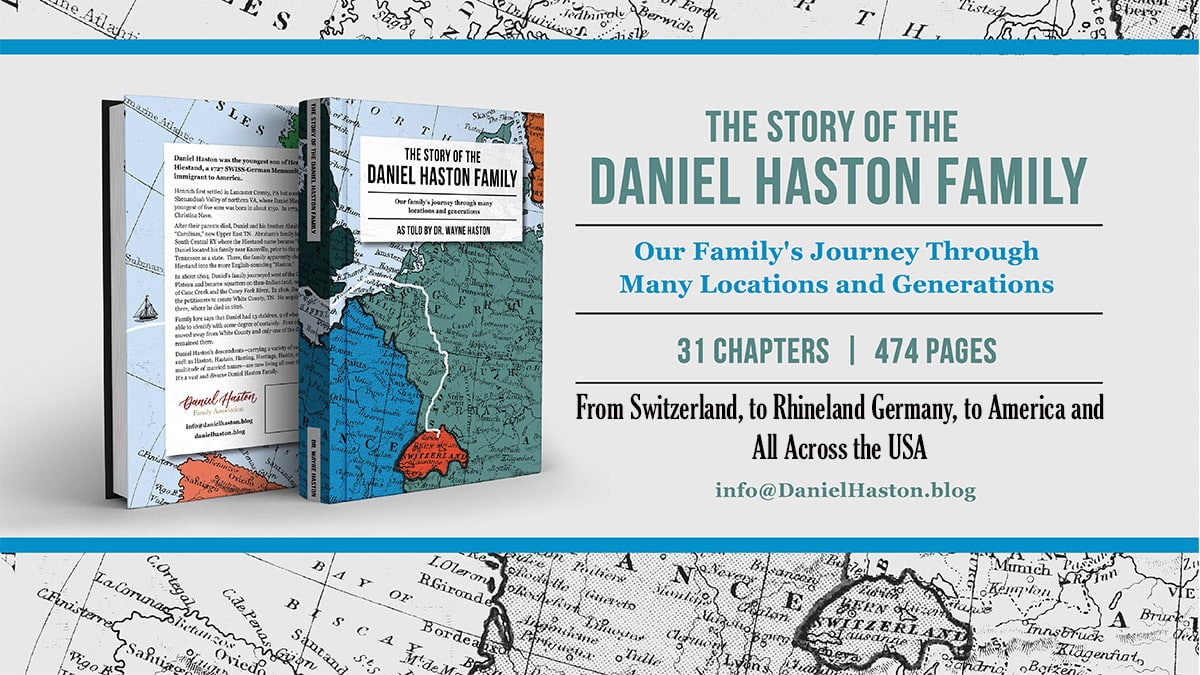
33 – Daniel Haston’s Final Years
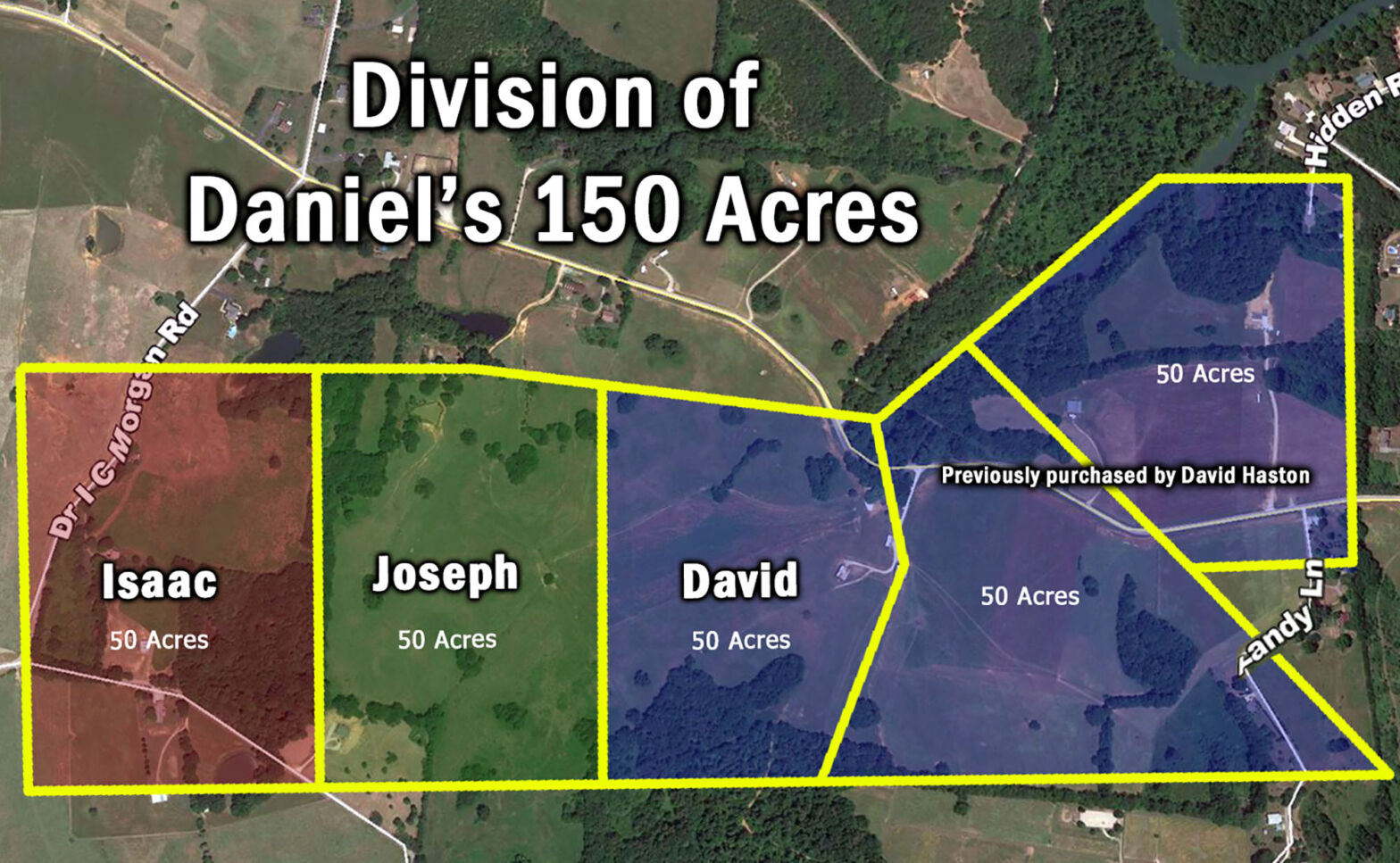
33 - Daniel Haston's Final Years
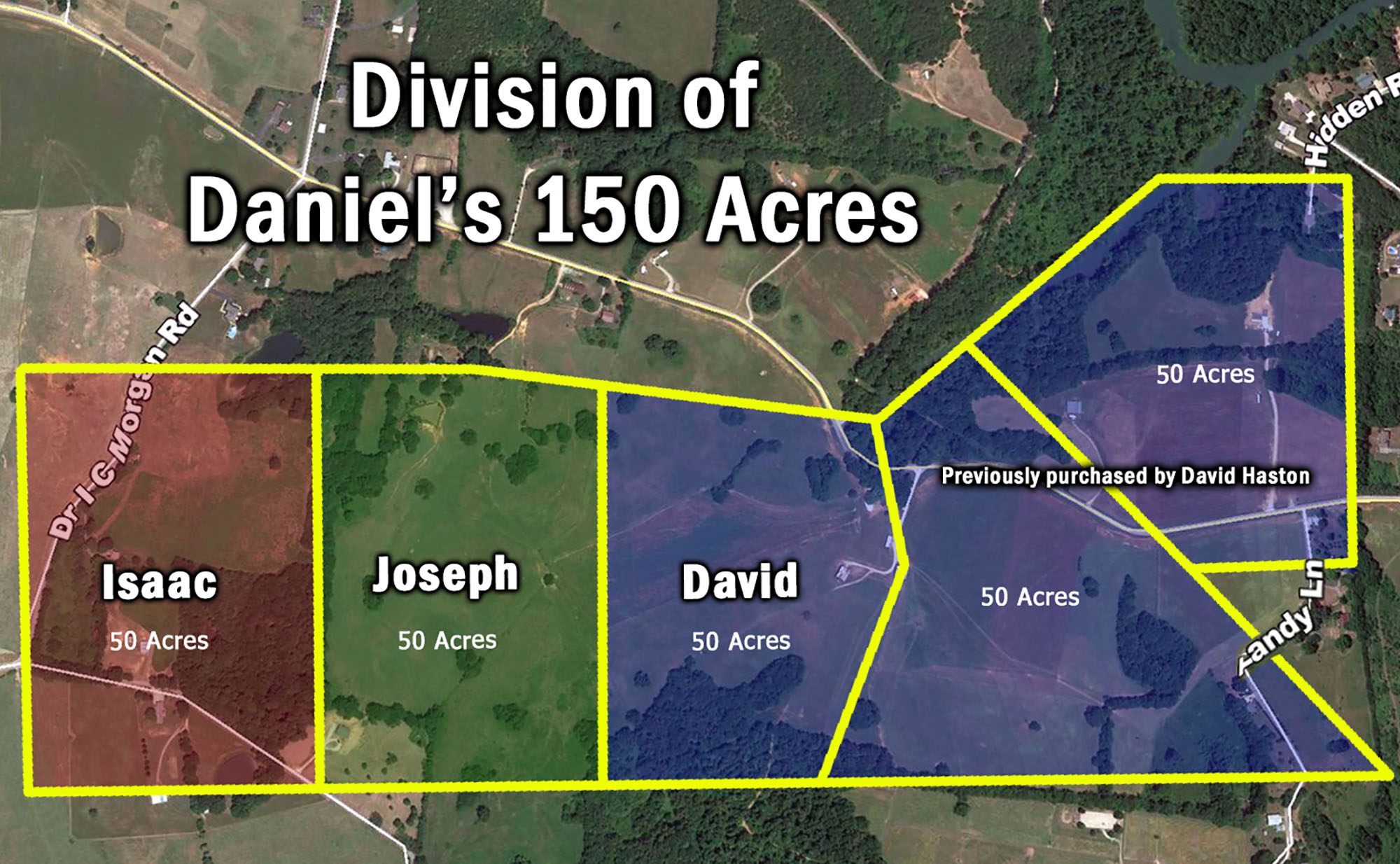
Daniel Haston lived his final years on his 150 acres farm in what we now know as the Cummingsville community of northern Van Buren County–southern White County until 1840. There are a few things that we KNOW about his final few years there and a few more things we can speculate about based on some bits of evidence.
Jacob Mitchell vs. Daniel Haston - Assault & Battery Case
In 1817, Daniel assaulted adjoining landowner Jacob Mitchell. Jacob Mitchell married Lucinda Hastings, and thus was Daniel’s son-in-law. The assault and battery case that originated the previous year, State vs. Daniel Haston, was prosecuted in the White County court in July 1818.[i] Daniel was fined fifty cents on a plea of guilty on July 24, 1818.[ii]
[i] White County, Tennessee County Court Trial Docket, 1818-1821. (original book)
[ii] White County, Tennessee Minutes of the Court of Common Pleas, 1818, 209, 227.
Frontier brawling to settle disputes were common and legal, but assault and battery was a different matter. “Official reaction to the offense often depended on the circumstances.” “The court could not condone the initial assault, but perhaps the small fine reflected the fact that both men had fought willingly after.”[i] Daniel was probably in his upper 60s at the time, so he probably didn’t engage in much of a brawl, if any.
[i] Finger, 157-158.
Daniel Divided His 150 Acres Among the Three Sons Remaining in Tennessee
There are indications that Daniel’s health was failing. In January 1821, his name appeared on Daniel Hastin appeared on an inventory of debts owed to a deceased Lawson Nourse, who was one of the earliest physicians in Sparta, Tennessee. Daniel was on the “Bad Debt” section of the list for a $3.00 debt, but the word “good” (for whatever reason) was written just to the right of his name. Perhaps he (or one of his sons) paid the bill after the list was created in January 1821 and before it was officially recorded in January 1827.
For a frontiersman like Daniel to consult a physician—at a cost of $3.00—would indicate that he was dealing with a painful or debilitating injury or a serious health problem. He was about 70 years old at the time, so it should not surprise us.
As was also true on the 1818 tax list, in 1822 Daniel does not appear, but Isaac appears with the 150 acres on Big Spring.[i] Isaac was probably farming his grandfather’s land for him at that time. It seems that Daniel had been struggling with a serious health condition or complications from an injury for the past four or five years or so. His son Isaac, who apparently was not yet a land owner, seems to have been tasked with farming his father’s 150 acres again. The ownership of Daniel’s farm was about to change.
[i] White County, Tennessee Property and Poll Tax, 1821-1825, 70. (original books)
Although there is no existing legal record of it, apparently Joseph inherited 50 acres of land from Daniel shortly prior to this time. It appears that Isaac also inherited 50 acres from Daniel, but quickly sold his inheritance. A May 15, 1822 deed shows that for $20 Isaac sold two of his acres to Rhodum Doyle, who lived in Shockley Cove.[i] The deed indicates that this lot was located on the west boundary of Daniel’s Grant #535 of 150 acres. The deed says these two acres were “…a part of a hundred and fifty acre tract originally granted to Daniel Haston by the State of Tennessee No. 535.”
[i] White County, Tennessee Deed Book I, 312.
David, the oldest son, inherited the 50 acre home place from Daniel but that probably did not happen until his father he died. In the 1827 tax list (year after Daniel died), David’s 100 acres had expanded to 150 acres.
Daniel Died and Was Buried in the Big Fork Cemetery
Daniel’s name was on a January 1, 1826 “list containing the names and number of free male inhabitants of the age of twenty years and upwards and resident citizens in Capt. Parkers company on the 1st day of January 1826 taken by David Hasting, Esq.” This was not a tax list with property and polls information, etc. It appears to have been a county census.[i]
[i] White County, Tennessee Property and Poll Tax, 1826-1829, 8.
Although the census was dated January 1, 1826, it wasn’t presented to the White County Court until July 10, 1826 and wasn’t certified until October 31, 1826. Daniel Hastin’s name was on this census, although it seems (by his absence on the next year’s tax list) that he died sometime during this year. Does this mean that he was still living by July 10, 1826 or even October 31, 1826, or does it mean the census included everyone who was living on January 1? His name was also on the 1826 tax list (recorded by David Haston, Justice of the Peace), which was generally taken early in the year.
This was the last year that our Daniel’s name appeared on a census or a tax list. Thus, it is assumed that he died sometime in 1826. Daniel was buried in the Big Fork Cemetery in the Cummingsville community of White County (now northern Van Buren County), Tennessee. His grave is located near the uppermost corner of the cemetery (northwestern section), very near where the Big Fork Baptist Church building seems to have been in the first half or so of the 19th century.
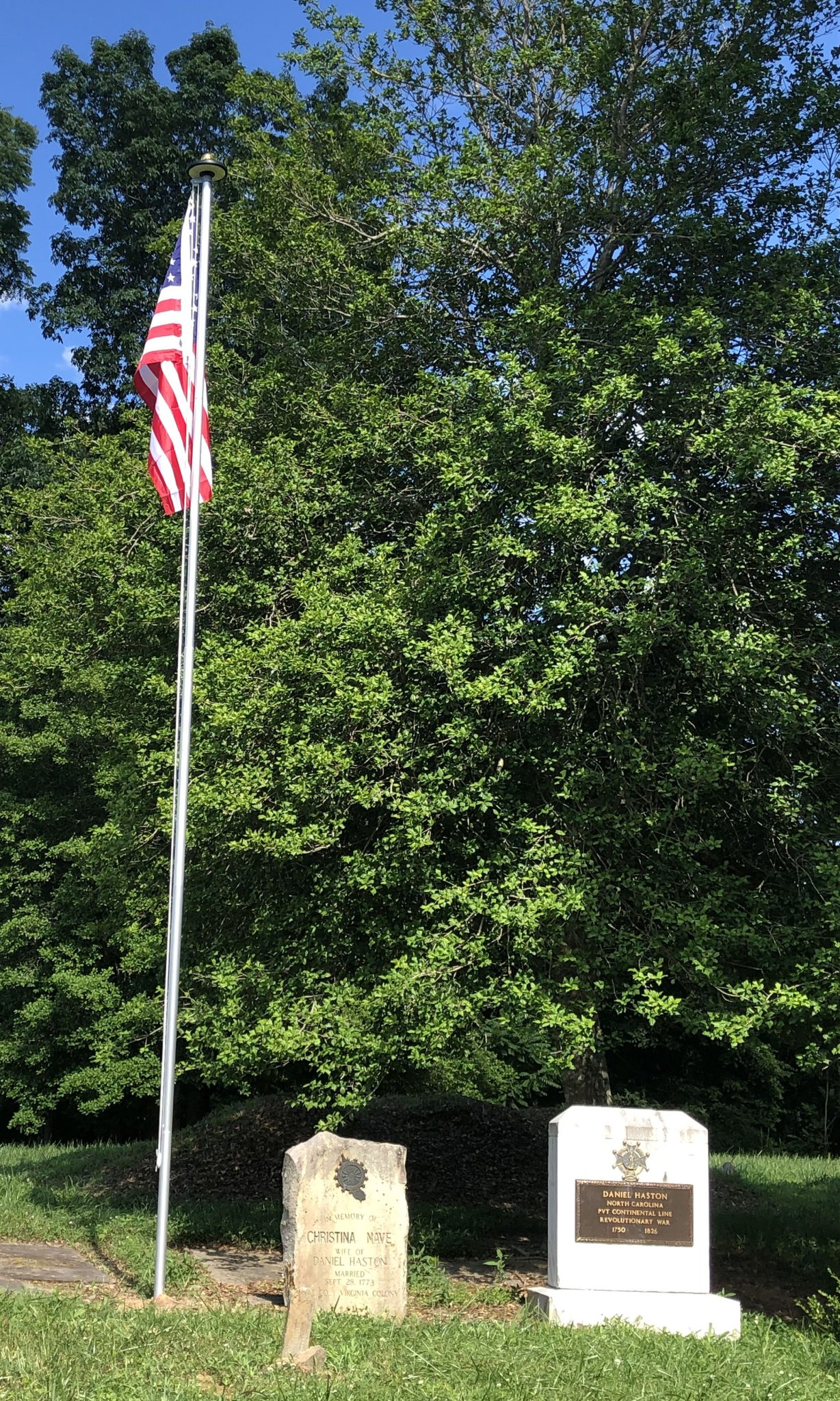
Daniel’s grave was unmarked for many years, but fortunately John Taylor Haston (Confederate veteran), in his old age pointed out the location of the grave to his son, Casto Haston.
Questions often arise regarding the Revolutionary War plaque on Daniel’s grave marker. It wasn’t placed there by the DAR or SAR. It was placed there by one of our long-standing Daniel Haston family historians, with whom he and I have agreed to disagree as friends about Daniel’s Revolutionary War experience, or absence of Revolutionary War experience.
I have explained my view that our Daniel was not a Revolutionary War veteran in these previous articles, a conclusion that I did not come to happily.
The "Christina Nave" Grave
You have heard the question–“Who is buried in Grant’s grave?” We could ask a similar question about the “Christina Nave” grave.
Frankly, nobody knows for sure. We do know with near-total certainty that our Daniel Hiestand/Haston married a Christina Nave in Shenandoah County, VA in 1773. But that is the only historical record we have for her.
We do know that a woman over age 45 was living in the Daniel Haston household in 1820, according to the census. Was that Christina Nave? Was it a second (or even third) wife? Was it a member of his family who was helping to care for him when he was about 70 years old with some apparent health problems? We just don’t know.
If you appreciated this article, please share it with others who might also enjoy it.

32 – Daniel Haston – Petitioner to Create White County, TN
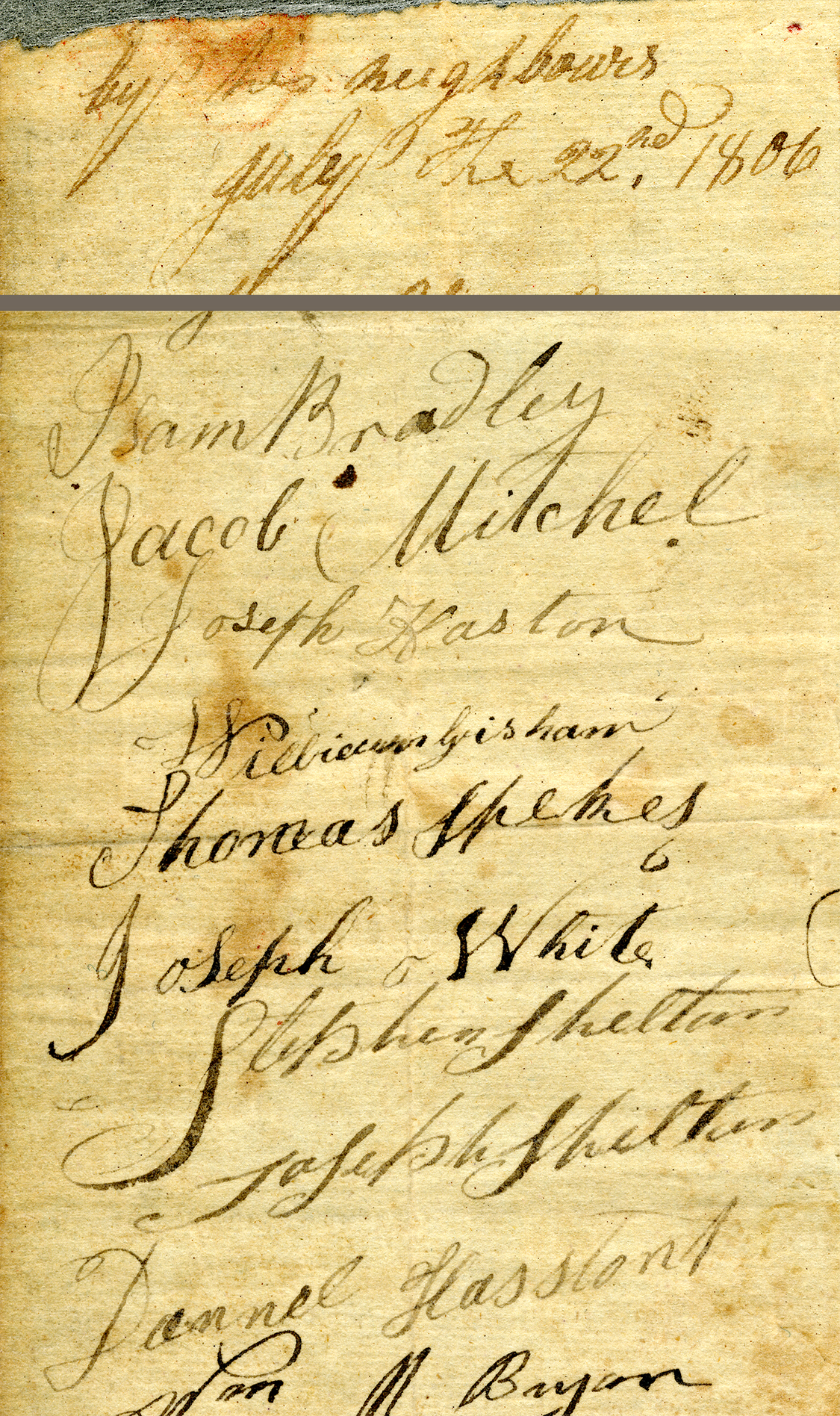
32 - Daniel Haston, A Founding Petitioner for White County, TN

The first record we have of Daniel Haston in (what became) White County, as well as some of his family members and friends, is the petition to create White County on July 22, 1806.[i] Four of the 155 names on the petition were Isam Bradley, Jacob Mitchell, Joseph Haston, and Daniel Hasstont, all of whom were identified in the previous article.
[i] Legislative Petition # 5-1-1806, “Petition for the Formation of White County from Jackson County, Tennessee.” (Nashville, TN: Tennessee State Library and Archives).
On April 25, 1806, President Thomas Jefferson ratified and proclaimed the October 25, 1805 Treaty with the Cherokee.* On and around July 22, 1806 a petition was distributed and signed by 155 residents of then-Jackson County, including Daniel Haston (Dannel Hasstont), Joseph Haston, and two of their Big Spring Branch settlement cohorts. This petition resulted in the establishment of White County—“Petition from Jackson County asking the county be divided and a new county established.”[i]
[i] Tennessee Legislative Petition # 5-1-1806, Petition to Create [White] County.
Why was his surname spelled “Hasstont“? It was because his original name was “Hiestand,” but often his German-speaking family added a “t” to the end. This wasn’t Daniel’s personal signature–it was written by someone who spelled it roughly like he heard it when Daniel, with his German accent, pronounced it to him.
The petition was read before the Tennessee Senate and House of Representatives on August 11, 1806, by Elijah Chisum. Chisum was a representative for Jackson, Wilson, Smith, and Sumner counties and later lived and died in White County. The petition was received favorably and a month later, September 12, 1806, and the General Assembly passed an act to form White County.
The name of “White County” was specified in the General Assembly’s act, but unfortunately the reason for the name was not stated. Since it was common to name counties after famous men, especially men who were renowned for their leadership in the American Revolution, the establishment of the United States, or contributions to the settlement or early development of the state, we can be reasonably certain that White County was named to honor some man—but what man? Three men have been suggested in various sources: John White (popular view since Monroe Seals wrote History of White County), General James White of Knox County, TN (most probable view as per evidence), and the general’s son, Hugh Lawson White (too early; his accomplishments were limited in 1806).
In order to be as accessible as possible to all citizens of a county, county seats are supposed to be located somewhere near the center of the county. That was particularly important in an era when transportation was very difficult. Rock Island is located at the northeastern edge of now-Warren County, near where White, Warren, and Van Buren counties come together. Although not in the exact center of the territory of the original White County, the first seat of government for White County at Rock Island was probably fairly close to the center of the more populated area of White County in 1806.
Original Boundaries of White County, TN
At the time of its creation White County included a very large area, extending all the way to the southern border of Tennessee.
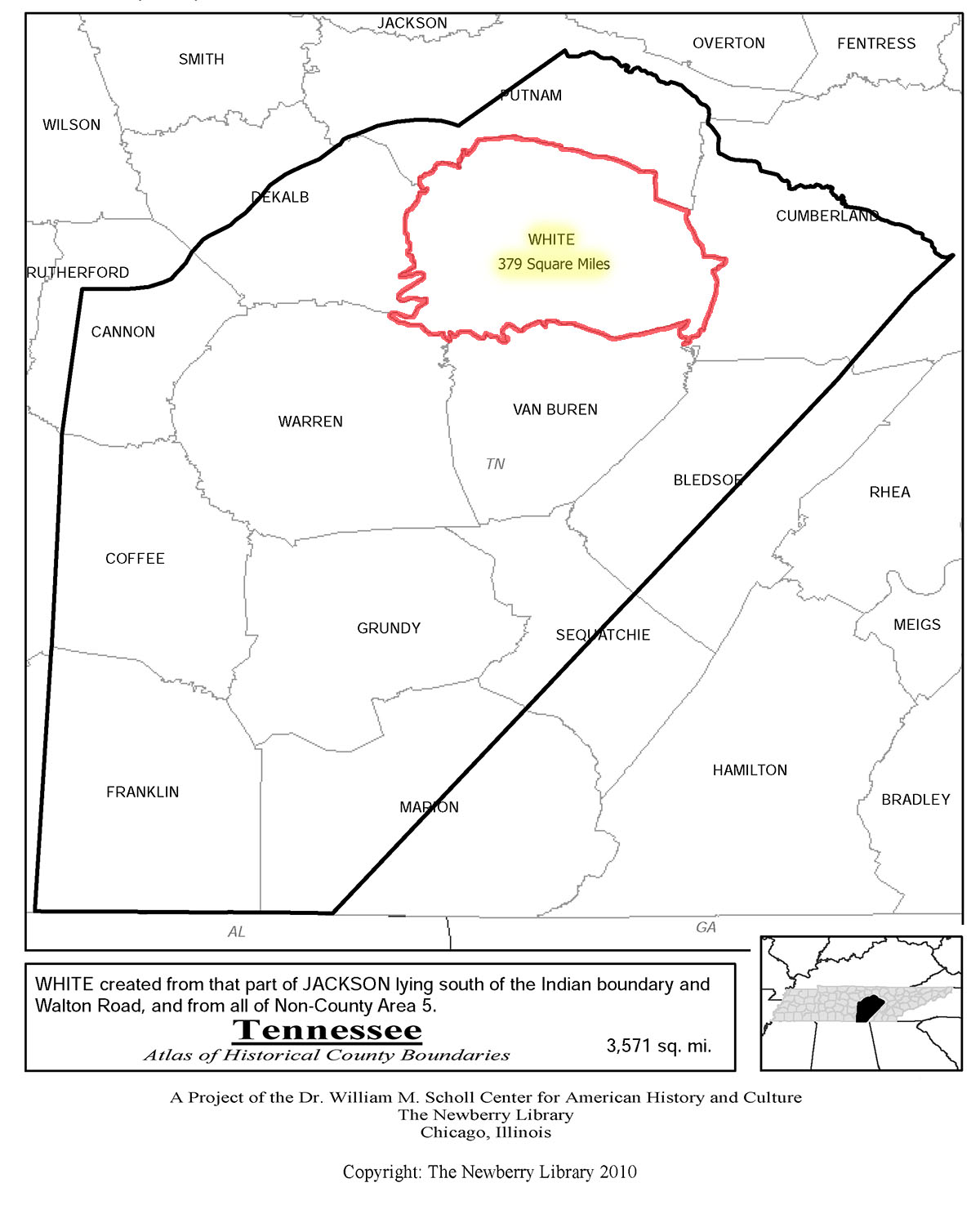
Less than 15 months later, White County was reduced from 3,571 square miles to 911 square miles. Warren County was created out of White County on November 26, 1807 and much of the southern and eastern portions of the original White County reverted to non-county status. Because Rock Island was in Warren County after the creation of that county, it was necessary to find a new location for the county seat of White County.
On the first Monday and Tuesday (January 1-2) of 1810, these seven men were chosen to be Commissioners to lead White County in the establishment of a permanent seat of justice: Thomas Bounds, Aaron England, James Fulkerson, Nicholas Gillentine (father-in-law of Daniel Haston’s son Jesse Haston), Turner Lane, Alexander Lowrey and Benjamin Weaver. A general site on the Calfkiller River was selected to establish the new county seat.
But would the town be located on the east or the west side of the river? The Commissioners put that decision to a vote and the east side was chosen. A log courthouse and jail was built in 1810. The courthouse was erected at a cost of less than $5,000 and was replaced by a two-story brick building in 1815, which stood until 1894.[i] Sparta was officially incorporated in 1813.
[i] “Commissioners Erect a City.”
White County was eventually reduced to 379 square miles, as several new counties were formed around it, with each new county taking a chunk of White County: Warren County (southwest) in 1807, Dekalb County (west) in 1838, Van Buren County (southeast) in 1840, Putnam County (north) in 1842, and Cumberland County (east) in 1855.
Daniel Haston's 150 Acres Survey and Grant #535
As mentioned in the previous article, Daniel Haston “squatted” on land near the convergence of Cane Creek and the Caney Fork River in what is now known as Cummingsville of Van Buren County. Contrary to what some have said, his 150 acres there had nothing to do with a military bounty land grant. He acquired the land from Thomas Dillon, a land speculator. But he was granted a “preference right” for locating and settling on the land prior to the establishment of the county–when it was still Cherokee territory.
On September 26, 1808, Tennessee Governor John Sevier officially issued Land Grant # 535 to Daniel Hastings which conveyed a tract of 150 acres, as far as we know it was the first land he ever owned.[i]
[i] Record Group 50, Roll 25, Book A, page 224. (Nashville, TN: Tennessee State Library and Archives)
Here’s the survey that led to Daniel Hastings (Haston) receiving Grant #535.

Become a Member of First Families of White County, TN
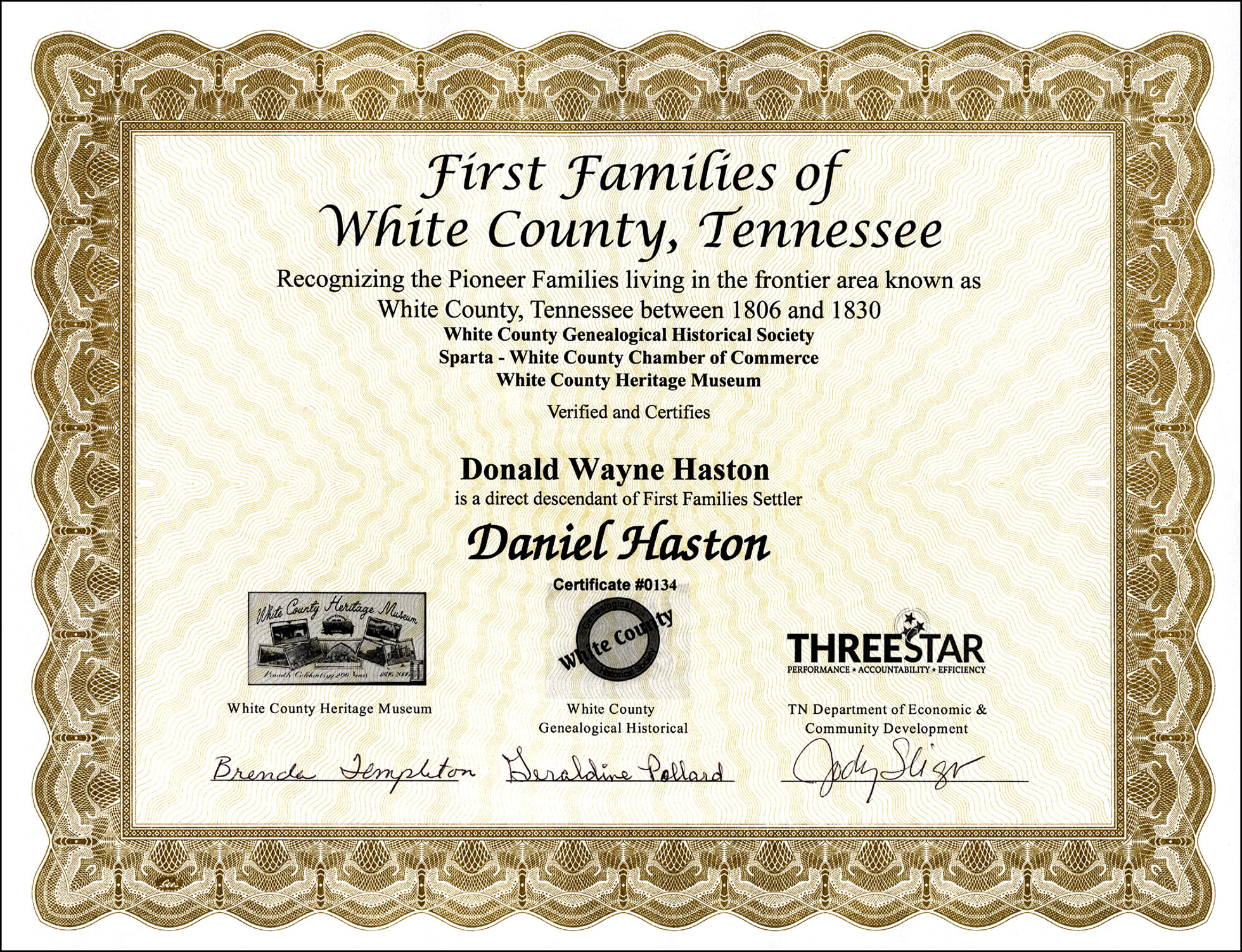
If you appreciated this article, please share it with others who might also enjoy it.

31 – Daniel Haston and the White County, TN “Big Spring” Settlers

31 - Daniel Haston & Other White County, TN Big Spring Settlers
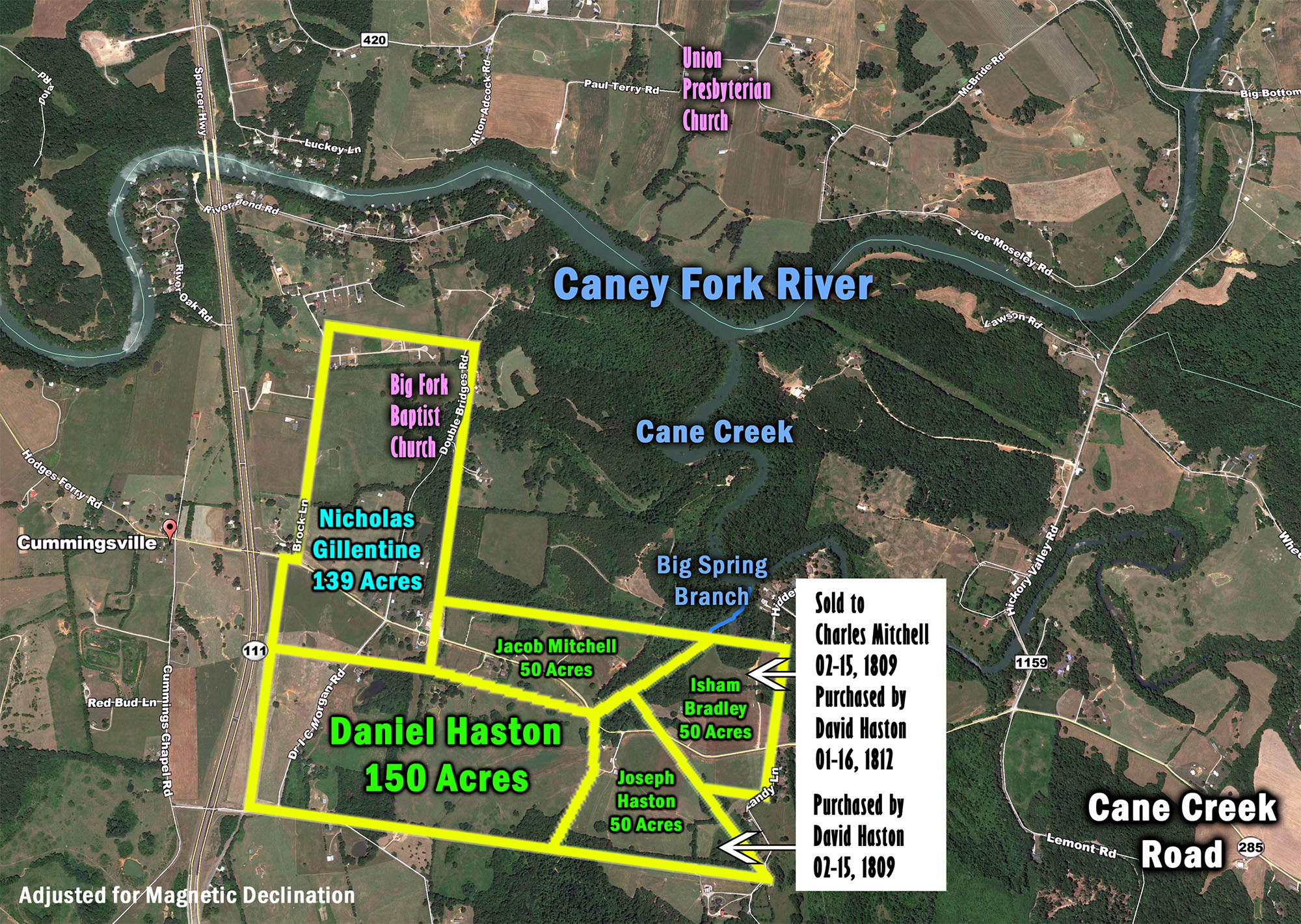
The area south of the Caney Fork River near the mouth of Cane Creek was a prominent settlement in the early 1800s. It was part of White County, Tennessee prior to its inclusion into newly formed Van Buren County in 1840. The abundance of water sources in that area was probably a major reason that early land-seeking settlers found the region so attractive. And since the land was covered in canebrakes, it was much easier to clear than timbered land.
A large perpetual spring flows into Cane Creek approximately one half mile before Cane Creek itself empties into the Caney Fork River. Early documents refer to this feeder stream as “Big Spring” or “Big Spring Branch.” The spring is certainly not impressive in the length of the stream, but the amount of crystal clear water that flows out of the mouth of the spring is quite impressive. Big Spring emerges from the base of the north side of the Cumberland Mountain and meanders only a few hundred yards before spilling into Cane Creek.

The quality and quantity of this water source, must have made the land surrounding Big Spring the prime homestead location for miles up and down the south side of the Caney Fork. Thus, we can probably assume that the families that claimed Big Spring as a focal point for their homesteads were some of the earliest settlers of that area.
In the pioneer years of early America, neighbors, friends, and family members often moved together as a group. At least three (but probably more) families accompanied Daniel Haston to White County and settled in a cluster of homesites around the Big Spring Branch that became known as the Haston Big Spring. The three families were all connected to Daniel Haston but in different ways.
The map at the top of this page clearly indicates that the four families strategically situated their claims in such a way as to provide access to the cool, clear, dependable waters of the Big Spring. A closer look at the dates on the map suggests that the placement of these claims was a well-planned, collective effort on the part of these four pioneer families. All four homesteads were officially located on the same day, August 28, 1807. Although the locations of their claims were made “official” on this day, there is evidence that they were “squatters” on these pieces of land for months, if not a few years, prior to August 1807. All four of these men, Isham Bradley, Jacob Mitchell, Joseph Haston, and Daniel Haston, signed the petition to form White County on July 22, 1806.
“Prior to 1805-1806, legally there were no rights for persons who may have settled in present day White, Van Buren, or Warren Counties. That land was still in fact legally the territory of the Cherokee. These early settlers were at some risk being there, but once the land had been ceded by the Indians, these hardy occupants were possessors of prize land. They could straightway begin the process of making entry, survey, and the issuance of a grant.”[i]
[i] Landon Daryle Medley, The History of Van Buren County, Tennessee: The Early Canebrakers (1840-1940). (Spencer, TN: published by author), 32.
The Four "Big Spring Branch" Settlers
Daniel Haston. As far as we know, this was the first property that Daniel Haston lived on that belonged to him, even though he was more than fifty years old at this time. He was definitely the “patriarch” of the group, since the head of the spring was on his property.
At the time the Hastons, Bradleys, and Mitchells initially settled the Big Spring area, they were probably living in constant danger of Indian attacks, since they were illegally squatting on Indian hunting lands. Monroe Seals stated, “Even after the Treaty of Tellico there were numerous skirmishes between whites and Indians.” One man born in White County in 1800, “told of numerous conflicts between whites and Indians during his boyhood.”[i]
[i] Seals, 5.
Although I know of no hard documentation to support the claim, there is some oral history that says a fortified station was erected on Daniel Haston’s property in order to provide protection from such attacks. It was supposedly known in those days as the “Haston Station.” The convenient access to Big Spring would have made it a logical place of refuge.
Joseph Haston. Joseph was Daniel’s 2nd son. The Big Spring flowed 495 feet down Joseph’s northwest property line. Joseph sold this tract to his brother David on February 15, 1809. On September 11, 1806 David was still in Knox County settling the sale of his 111 acres to Ezekiel Baldwin for $490.00. David’s first known appearance in White County was February 10, 1808 as a road worker, but he must have been in the county earlier enough to have been known. Joseph was probably commissioned by David to purchase the White County land and hold it for him until he could settle his Knox County business, move to White County, and settle his family.
Jacob Mitchell. Although Jacob Mitchell’s land did not have direct access to the head of the spring, his property line ran along Big Spring Branch for some 1500 feet, which gave him more frontage to the stream than any of the four Big Spring area tracts. Jacob Mitchell was a son-in-law of Daniel Haston, husband to Daniel’s daughter Lucinda.
Isham Bradley. Isham Bradley’s relationship to the Daniel Haston family can be traced back to Knox and Blount Counties, Tennessee. Isham was the bondsman for David Haston’s May 5, 1800 marriage to Peggy Roddy. And David had filled the same role for Isham Bradley’s marriage to Susana Matlocks on May 13, 1798 in Blount County. Was he a relative to the Hastons or just a friend? Since we know he married Susana Matlocks, he must not have been a son-in-law of Daniel Haston, as was Jacob Mitchell. Whatever the relationship was, it was strong enough for him to travel to the wilderness of middle Tennessee in order to settle adjacent to the Haston family (even before his marriage bondsman friend David arrived to the area).
If you appreciated this article, please send it to others who might enjoy it.

17 – Ballenberg Open-Air Museum

17 - Ballenberg Open-Air Museum
On Wednesday, July 21, 2023, our Hiestand-Haston heritage tour group will visit the Ballenberg Open-Air Museum.
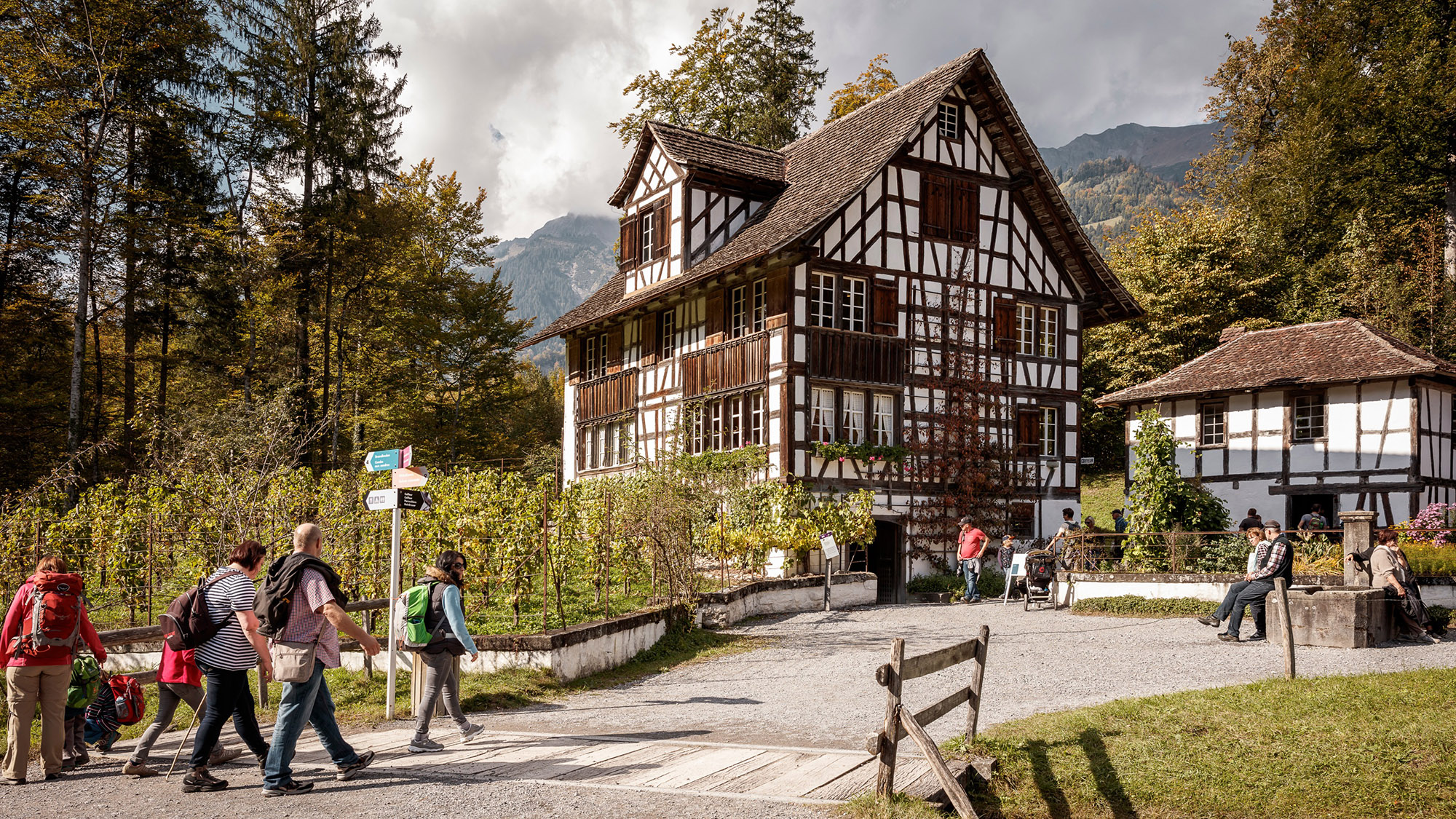
Ballenberg is an open-air museum in Switzerland that displays traditional buildings and architecture from all over the country. Located near Brienz in the municipality of Hofstetten bei Brienz, Canton of Bern, Ballenberg has over 100 original buildings that have been transported from their original sites. It is a Swiss heritage site of national significance.
In addition to the main attraction of the buildings themselves, some of the industrial and crafting buildings still operate to give demonstrations of traditional rural crafts, techniques, and cheesemaking. There is also a sizable number of farmyard animals on the grounds.
Founded in 1978, the museum features buildings from all over the country and has structures from almost all of the cantons. The buildings are set in surroundings appropriate to their type (farm buildings surrounded by small fields etc.) with pathways snaking across the 660,000 square metres (164 acre) site. Most buildings allow the visitor to walk around the rooms, each recreated from the time period of the building or brought over wholesale when the building was transplanted. -Wikipedia
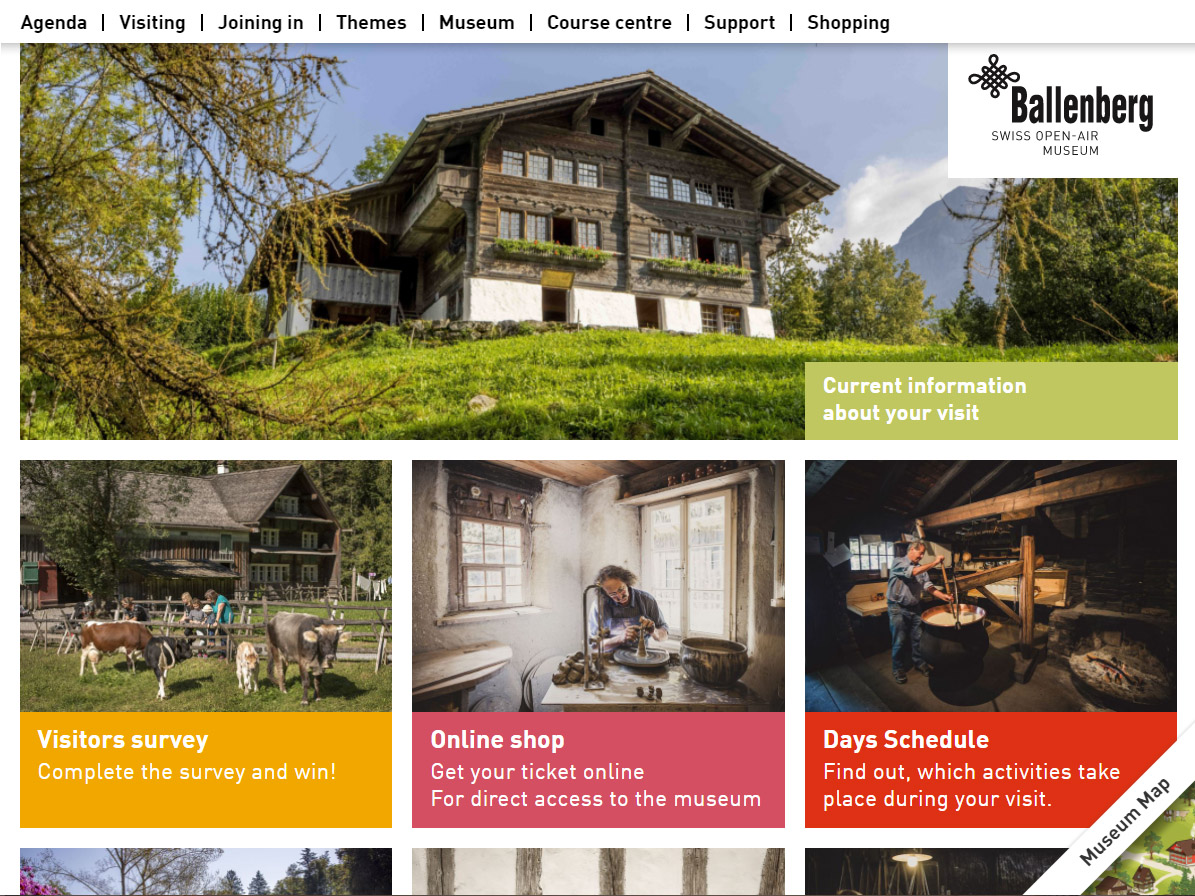
Share this with Hastons or related family members who might be interested in the June 14-27, 2023 Hiestand-Haston European Heritage Tour.

16 – Lucerne and the Wooden Chapel Bridge

16 - Wooden Chapel Bridge in Lucerne, Switzerland
And Shopping in this Beautiful City!
In the afternoon of June 20, 2023, our Hiestand-Haston heritage tour group will visit the Swiss city of Lucerne. Not only will we see and stroll across this historic bridge, but there will also be time for shopping in Lucerne.

The Kapellbrücke (literally, Chapel Bridge) is a covered wooden footbridge spanning the river Reuss diagonally in the city of Lucerne in central Switzerland. Named after the nearby St. Peter’s Chapel, the bridge is unique in containing a number of interior paintings dating back to the 17th century, although many of them were destroyed along with a larger part of the centuries-old bridge in a 1993 fire. Subsequently restored, the Kapellbrücke is the oldest wooden covered bridge in Europe as well as the world’s oldest surviving truss bridge. It serves as the city’s symbol and as one of Switzerland’s main tourist attractions.
Part of the bridge complex is the octagonal 34.5 m (113 ft) tall (from the ground) Wasserturm, which translates to “water tower,” in the sense of ‘tower standing in the water.’ The tower pre-dated the bridge by about 30 years. Over the centuries, the tower has been used as a prison, torture chamber, and later a municipal archive as well as a local treasury. Today, the tower is closed to the public, although it houses a local artillery association and a tourist gift shop.
The bridge itself was originally built c.1365 as part of Lucerne’s fortifications. It linked the old town on the right bank of the Reuss to the new town on the left bank, securing the town from attack from the south (i.e. from the lake). The bridge was initially over 270 metres (890 ft) long, although numerous shortenings over the years and river bank replenishments mean the bridge now totals only 204.7 metres (672 ft) long. It is the oldest surviving truss bridge in the world, consisting of strutted and triangulated trusses of moderate span, supported on piled trestles; as such, it is probably an evolution of the strutted bridge.
The Kapellbrücke almost burned down on 18 August 1993, destroying two-thirds of its interior paintings. Shortly thereafter, the Kapellbrücke was reconstructed and again opened to the public on 14 April 1994 for a total of CHF 3.4 million. –Wikipedia
Beautiful Lucerne
Walking Across the Chapel Bridge
Share this with Hastons or related family members who might be interested in the June 14-27, 2023 Hiestand-Haston European Heritage Tour.

– June 14-27, 2023 – Hiestand/Haston European Heritage Tour – Terms and Conditions

2023 Hiestand-Haston Europe Tour Price and Other Details
June 14-27, 2023 - Switzerland and Rhineland Germany
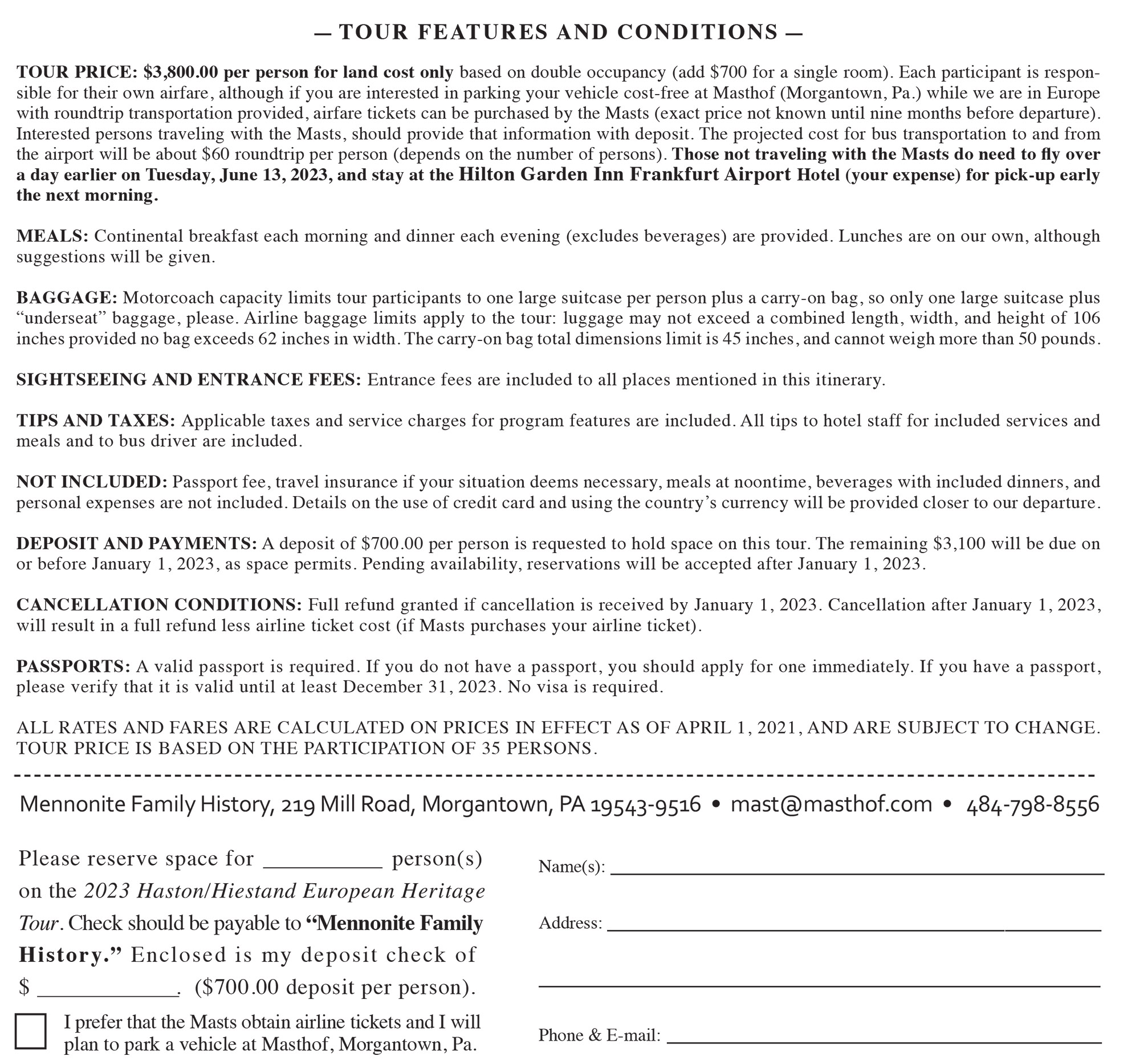
Share this with Hastons or related family members who might be interested in the June 14-27, 2023 Hiestand-Haston European Heritage Tour.

30 – Daniel Haston Family Moves Across the Cumberland Plateau

30 - Our Hastons Moved West of the Cumberland Mountain
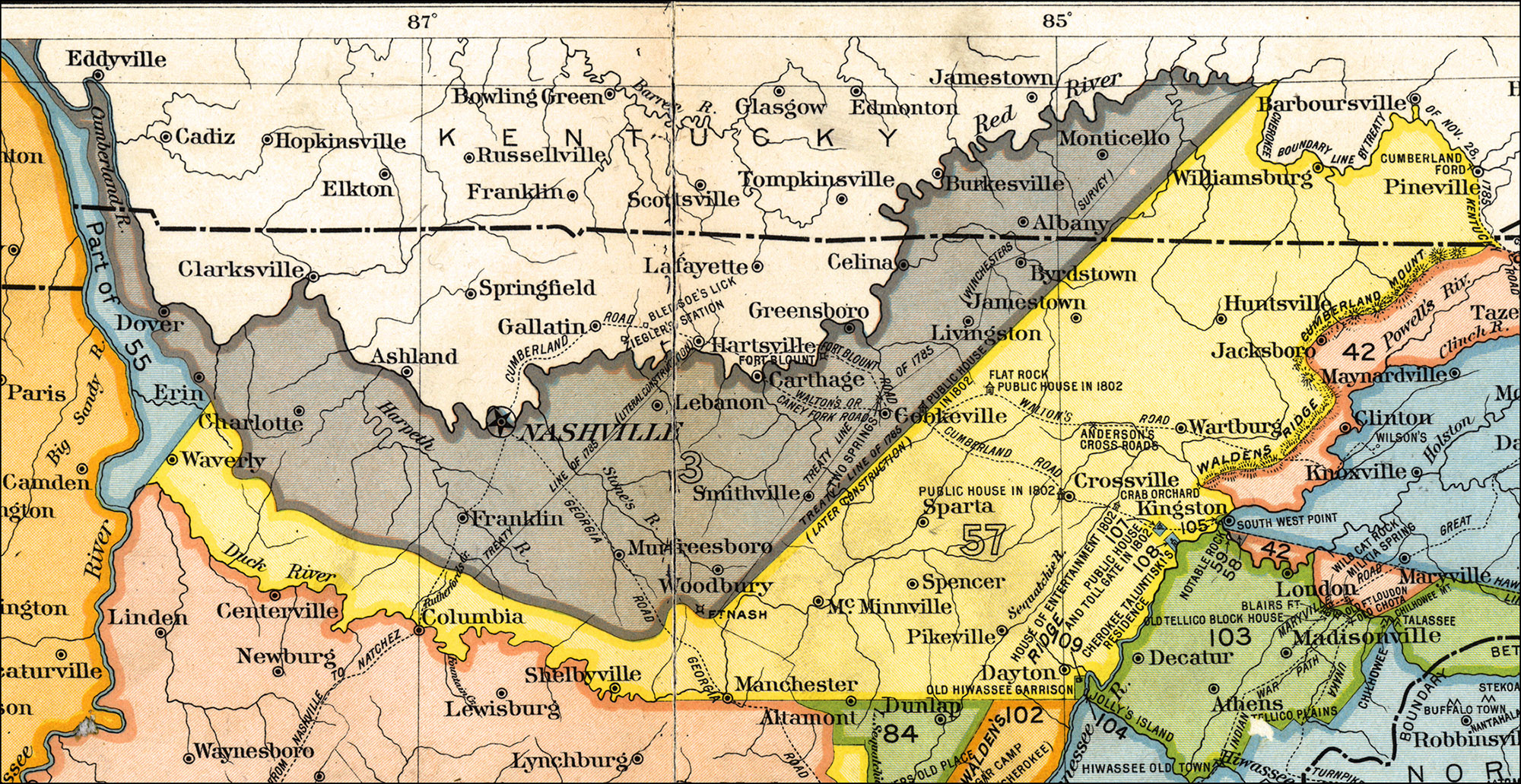
Through the Tellico Treaties of October 25 and 27, 1805, Cherokee chiefs ceded to the United States a large area of Middle Tennessee. On April 24, 1806, the October 1805 treaties were officially proclaimed by the President of the United States. Much of Middle Tennessee, including then-future White County, was legally opened for white pioneers. White County historian Monroe Seals noted: “After the Treaty of Tellico the country settled up rapidly.”[i]
[i] Monroe Seals, History of White County. (1935; reprinted, Salem, MA: Higginson Book Company, n.d.), 6.
The 1805 cession of land from the Cherokees is indicated by the yellow (57) section of the above map. The Cherokee surrendered their claims “from the Kentucky line on the north to [the future towns of] Manchester and Altamont on the south, from the Tennessee River on the east to the neighborhood of Livingston, Cookeville, Smithville, and Woodbury on the west.”[i] The ceded territory included the future locations of Sparta, Spencer, McMinnville, and Crossville.
[i] Hamer, 243-244.
Assuming Daniel was born in about 1750, the first 33 years (or so) of his life were spent in Virginia and the next 21 years (or so) were spent in Western North Carolina/East Tennessee. He lived out the remainder of his life (22 years or so) near the confluence of Cane Creek and the Caney Fork River in what became White County, Tennessee, nearly 40 years before it became a part of northern Van Buren County.
Exactly when Daniel moved to White County is not known. My best guess is that he left Knox County sometime between the spring of 1803 and mid-1804. I have theorized that Daniel may have made a land-hunting trip across the Cumberland Plateau sometime between October 1798 and January 1800. That is also a guess, but there is enough evidence to give it some degree of credibility.
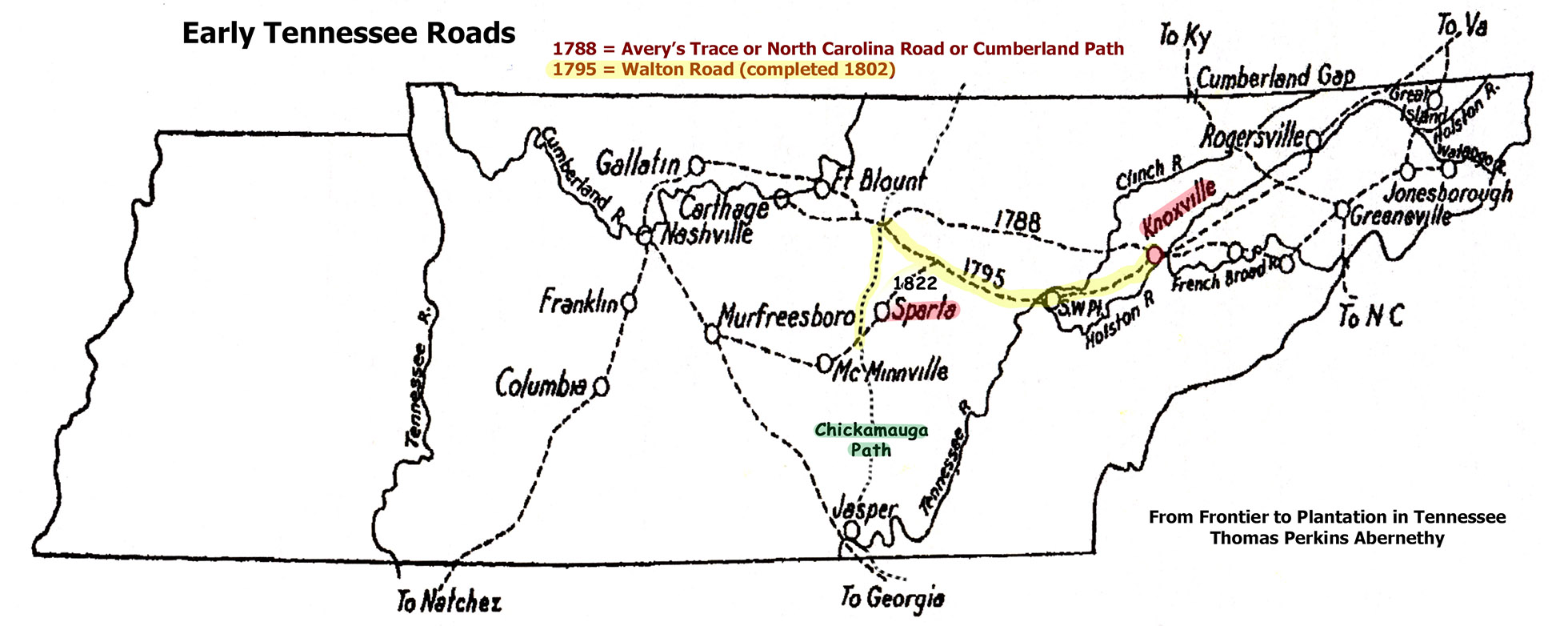
In September 1788, the steep and rugged Avery Trace (also called the North Carolina Road) was opened, it began at the Clinch River and entered the Cumberland Mountain from the east through Emory Gap (near the present town of Harriman, Tennessee). The Trace was originally nothing more than a horse path, but was widened to accommodate wagons in 1795. It crossed the Cumberland Plateau and began to descend the western slope at Standing Stone (now Monterey), then continued on to Nashville by way of Fort Blount, Dixon Springs and Winchester’s Station (now site of Gallatin).
But a better, wider, and more direct road—a wagon road from the beginning—to Nashville was opened fourteen years later, September 1802.* This newer road, which took a slightly more southernly route, was constructed under the leadership of William Walton, and became known as the Walton Road or Cumberland Road/Turnpike. It was about 15 feet wide on flat land and 12 feet wide through the mountains. On the east, it started at Southwest Point, south of Kingston, climbed up Kimbrough’s Gap, crossed the plateau through Crab Orchard, ran about four miles north of the future site of Crossville (originally Lambeth’s Crossroads), and on to Standing Stone.[i] On the west side of the Cumberland Plateau, Walton Road passed through the sites that became Cookeville, Baxter, Carthage, Gallatin, before ending in Nashville.[ii] It ran westward about 20 miles north of where Sparta was located four years later.
*This Walton Road was completed in 1801 or 1802, but was authorized in 1794 and construction began on it in 1795, beginning in Carthage, Tennessee (where William Walton lived) and working eastward.
[i] W. Calvin Dickinson, Cumberland County. (Cookeville, TN: Tennessee Technological University, 1992), 6.
[ii] John Dawson Boniol, Jr., “The Walton Road,” Tennessee Historical Quarterly, XXX, no. 4 (Winter, 1971): 403-407.
If Daniel scouted for land in Middle Tennessee in 1799 or 1800, he would probably have crossed the Cumberland Mountain on the Avery Trace. But when he moved to his new homesite on the Caney Fork River in 1803 or 1804, he and his family and their friends would have undoubtedly travelled the Walton Road.
The branch off of the Walton Road that turned south to Sparta was not constructed until about 1822. So Daniel’s clan probably followed the Indian Chickamauga Path, from the Walton Road as it passed through White Plains (near now what is Algood in Putnam County) down into White County to the Caney Fork River. Somewhere along the way, the Chickamauga Path branched in two directions.
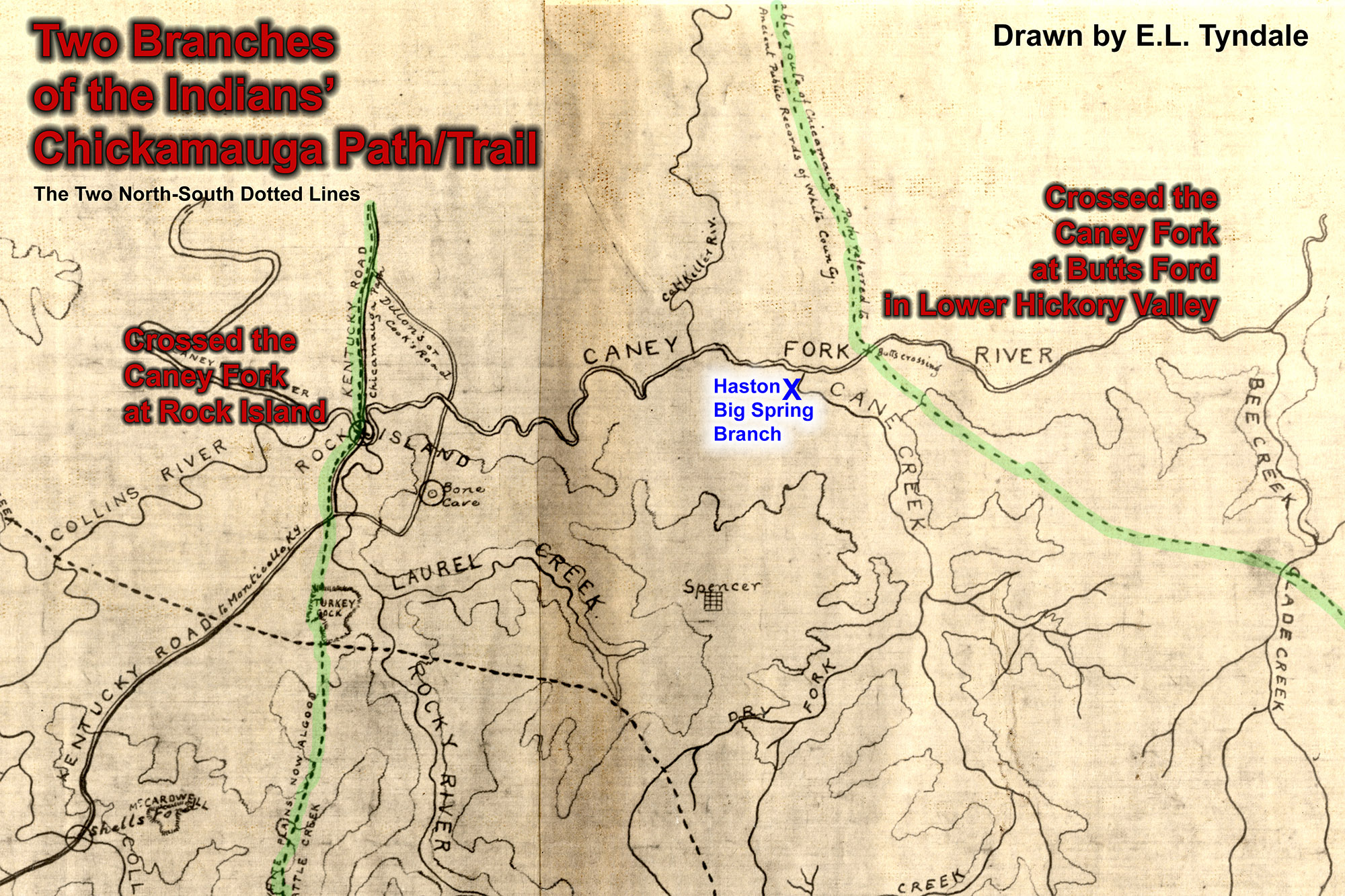
The Western Branch of the Chickamauga Path/Trail ran south through Beersheba Springs, Coalmont, Tracy City, west of Jasper to the “Lower Towns” of Chickamauga Indians. The Eastern Branch ran southeast through Hickory Valley and Big Bottom, up the Cumberland Mountain, crossed Bee Creek, and on to Pikeville and probably to the Cherokee “Upper Towns,” as well as the Chattanooga-Chickamauga area.
The Eastern Branch of the Chickamauga Path crossed the Caney Fork River at Butts Ford, only about 1.7 miles upriver from the mouth of Cane Creek near the Haston’s Big Spring where Daniel and other “Big Springs” families settled.
How did Daniel Haston locate the land he and others claimed on or near the Big Spring Branch? We can only guess. But possibly he followed one branch of the Chickamauga Path to the Caney Fork River, then searched up or down the river until he discovered Cane Creek and the Big Spring Branch. Or, possibly he had met Thomas Dillon in Knoxville who directed him to the Cane Creek of the Caney Fork River site. Dillon had acquired a patent (based on Certificate #313) for 5,000 acres that included many 100s of acres in the general area where Daniel Haston settled.
If you appreciated this article, please share it with others who might be interested.

14 – Were Our Ancient Swiss Hiestands Spiritist-Pagans?

14 - Were our Ancient Swiss Hiestands Spiritist-Pagans?
Although I can’t say for sure, it is probable, that our Medieval ancestors were pagans who lived in a high-mountain area of what is now the northern edge of Canton Zug, Switzerland. Our June 2023 Hiestand-Haston tour group will visit this area.

The (Swiss) hills were alive with the sounds of witchcraft and black magic!
Many centuries before Julie Andrews and the 1965 “The Sound of Music” movie, the mountains of Switzerland were alive with very different sounds–the sounds of sorceries and incantations.
In ancient Rome a person living in a rural area or village was called paganus. When Christianity became generally accepted in the towns and cities of the empire, paganus (English, pagan) was used to refer to a villager who continued to worship the old gods. “Old gods” paganism was common throughout Europe even after Christianity was introduced and spread. As Christianity began to take root in Switzerland in the 4th century and following, pagans retreated to the highlands to avoid the control of the State and the influence of the Church.
We know that our earliest known Hiestands originated from near the village of Hutten, just below a highland area known as Gottschalkenberg. This broad crescent-shaped, soft-topped mountain south of Wädenswil and Richterswil was a center of ancient paganism at an elevation of 3,816 feet.
Although you may read that Gottschalkenberg literally means “God’s servant,” schalk conveys the idea of some kind of foolery, so it translates to something like, “The mountain of God’s joke”[i] or “The mountain of God’s fools,”[ii] probably referring to the foolish pagans who lived there.
[i] Nicole Billeter, email to Wayne Haston, June 15, 2021.
[ii] Ross Baughman, email to Wayne Haston, April 8, 2021.
Gottschalkenberg within the northern boundary of Canton Zug, overlooking Lake Zürich and the mountain side down to the lake’s south shore.
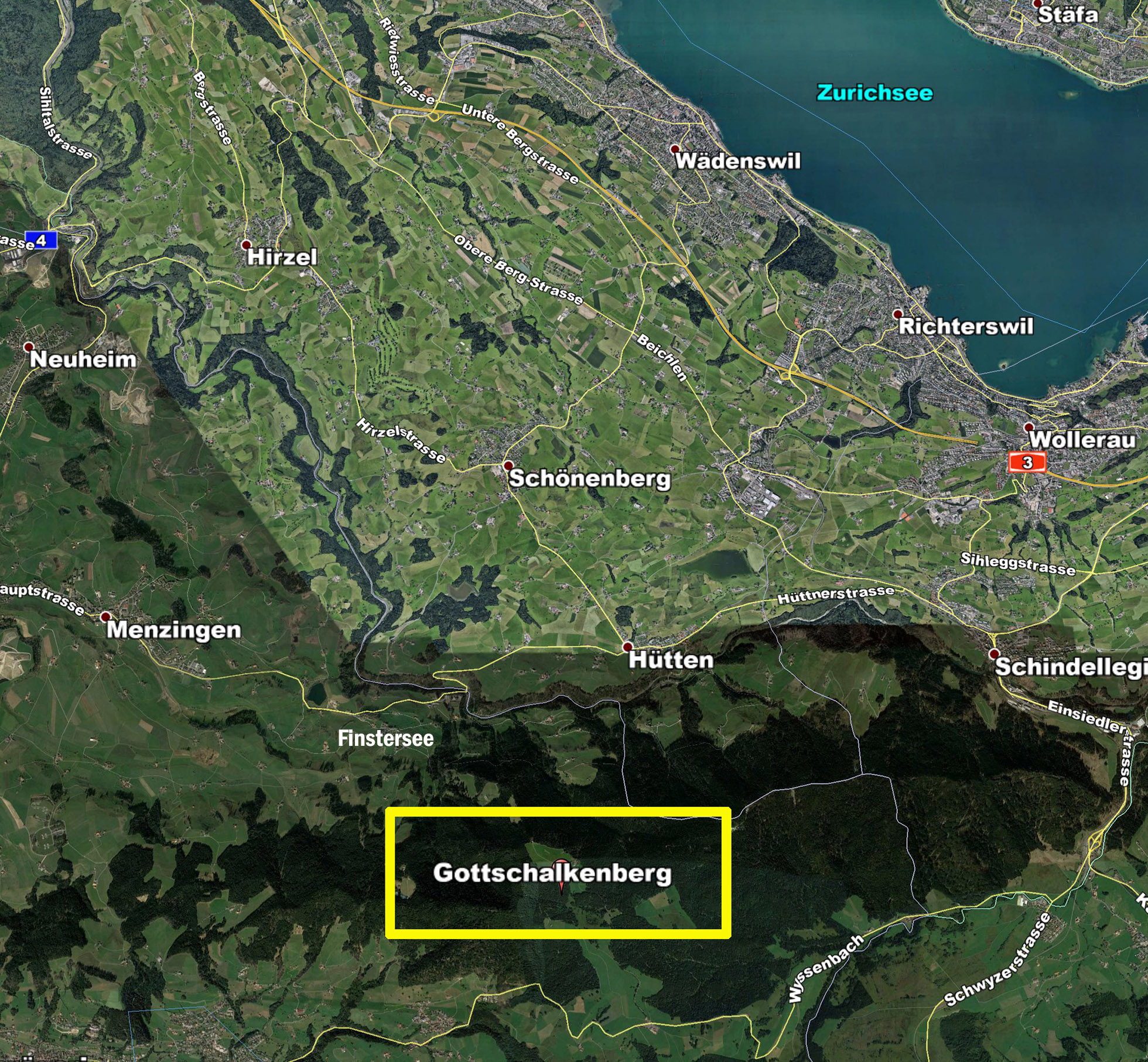
From some of the early inhabitants of Finstersee, a village near Gottschalkenberg, a myth emerged to try to explain the origin of Gottschalkenberg. It’s just one of many magical myths from the Gottschalkenberg area.
In misty, long-agos, the first humans to settle Finstersee (just 4.7 km above Hutten) cleared the land, planted their gardens and baked their first bread. Their lives proved so good that soon a crop of children crowded the only spots big enough and flat enough for play. One from among them drew the lott, and was obliged to petition the gods for more land.
“Then clear more land! Cut the trees and dry out the swamps,” came back the only answer they got.
This advice solved their needs for a while, but when it could no longer, another envoy went out looking for the king of the devils, ready to make a deal with him.
He was glad to hear their pleas and promised to fulfill their wishes. He sent a whole troop of little devils to the top of Gottschalkenberg, where they tunneled inside it, and with their shoulders, lifted up. The settlers of Finstersee hugged each other, drank themselves silly and danced with delight, for by stretching new hillsides into the land, more acres belonged to them now and could be put to work. The people swore their thanks and fidelity to the devil, but only learned later how much harder the work would be in every way for every day of the rest of their lives.[i]
[i] J. Ross Baughman, The Chains Rejoined, 18-19.
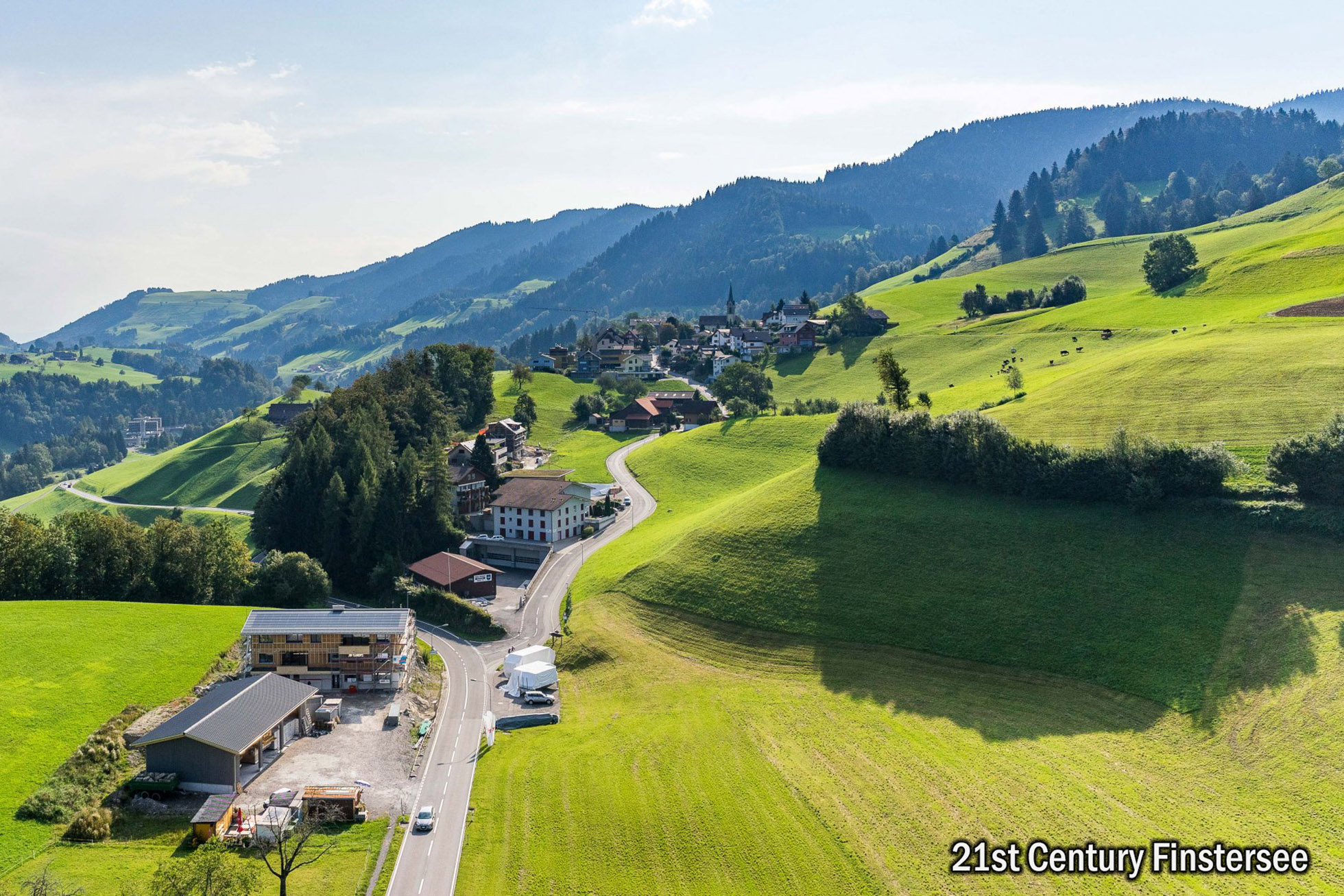
In time, some of these pagans probably came into contact with Christians and were converted to Christianity. They came down from the highlands to the south shore of Lake Zürich, four and a half miles as an eagle flies. They purchased hereditary rights to farm land, from the Catholic Knights of St. John, and worked in the old Wädenswil Castle and began to settle around the castle in Wädenswil and Richterswil.
Our June 2023 Hiestand-Haston Tour Group Will Visit Beautiful Gottschalkenberg
Gottschalkenberg overlooks Lake Zurich, from the south. The bunkers you see in the video were built there to protect Switzerland from enemy aircraft during World War II. Amazingly, Switzerland was able to maintain its neutrality during the war and avoid bombardments by Nazi Germany and its allies.
Share this with Hastons or related family members who might be interested in the June 14-27, 2023 Hiestand-Haston European Heritage Tour.

July 22-23, 2022 Daniel Haston Family Heritage Days

Gathering for All Haston Families - July 22-23, 2022
The First ALL Daniel Haston Family Get-Together in 200+ Years!
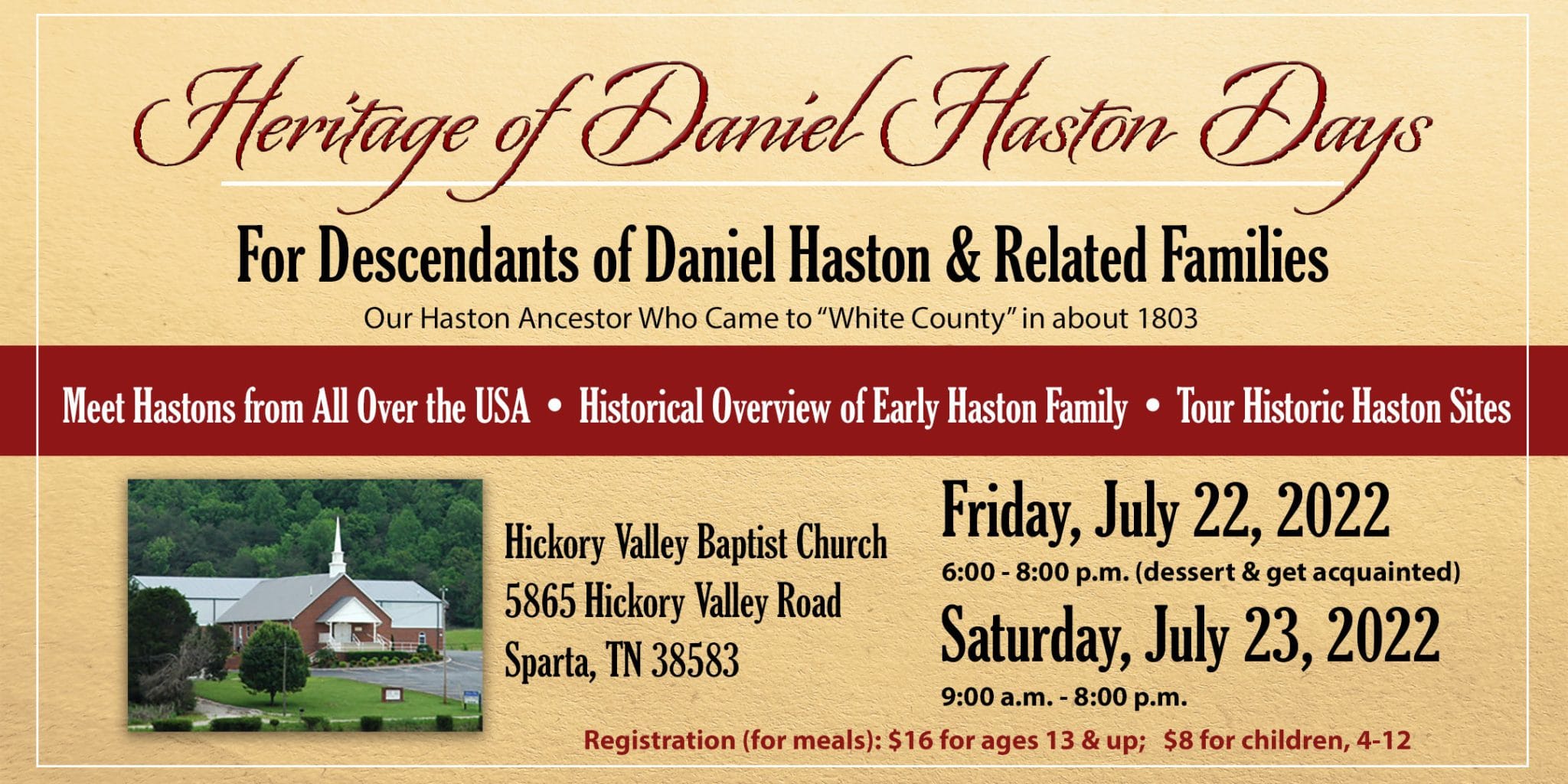
The Schedule
Important: Keep in mind that we will be on Central Time, so adjust your watches & thinking.
Friday Evening, July 22, 2022 (6:00-8:30 pm CENTRAL Time)
Fun & informal get-acquainted activities, with “potluck desserts,” which in Tennessee means to bring some kind of dessert (homemade or bought) to share with others in the group.
Plus, most of the interest centers will be available (Wayne’s book signing, old family photos, photo scanning, photography studio, family heirlooms, military veterans’ photos and heirlooms, etc.).
Saturday, July 23, 2022 (9:00 am - 8:30 pm CENTRAL Time)
9:00 a.m. – coffee, orange juice, milk (&, etc.) & doughnuts, etc.
9:00 a.m. – 11:00 a.m. – Visit the interest centers and mingle
11:00 a.m – 12:30 p.m. – Group meeting for adults & teens
11:00 a.m. – 12:30 p.m. – Fun but family history related group-time for children
12:30 – 2:00 p.m. – Catered lunch (covered by registration fee)
2:00 – 6:00 p.m. – Historic Haston Sites Tour
6:00 – 8:00 p.m. – Left-overs “supper” (as we call it in Tennessee), interest centers, and informal debriefings about the tour sites
8:00 p.m. – Clean up the facilities (need lots of help with this)
Directions from Highway 111 to Hickory Valley Baptist Church
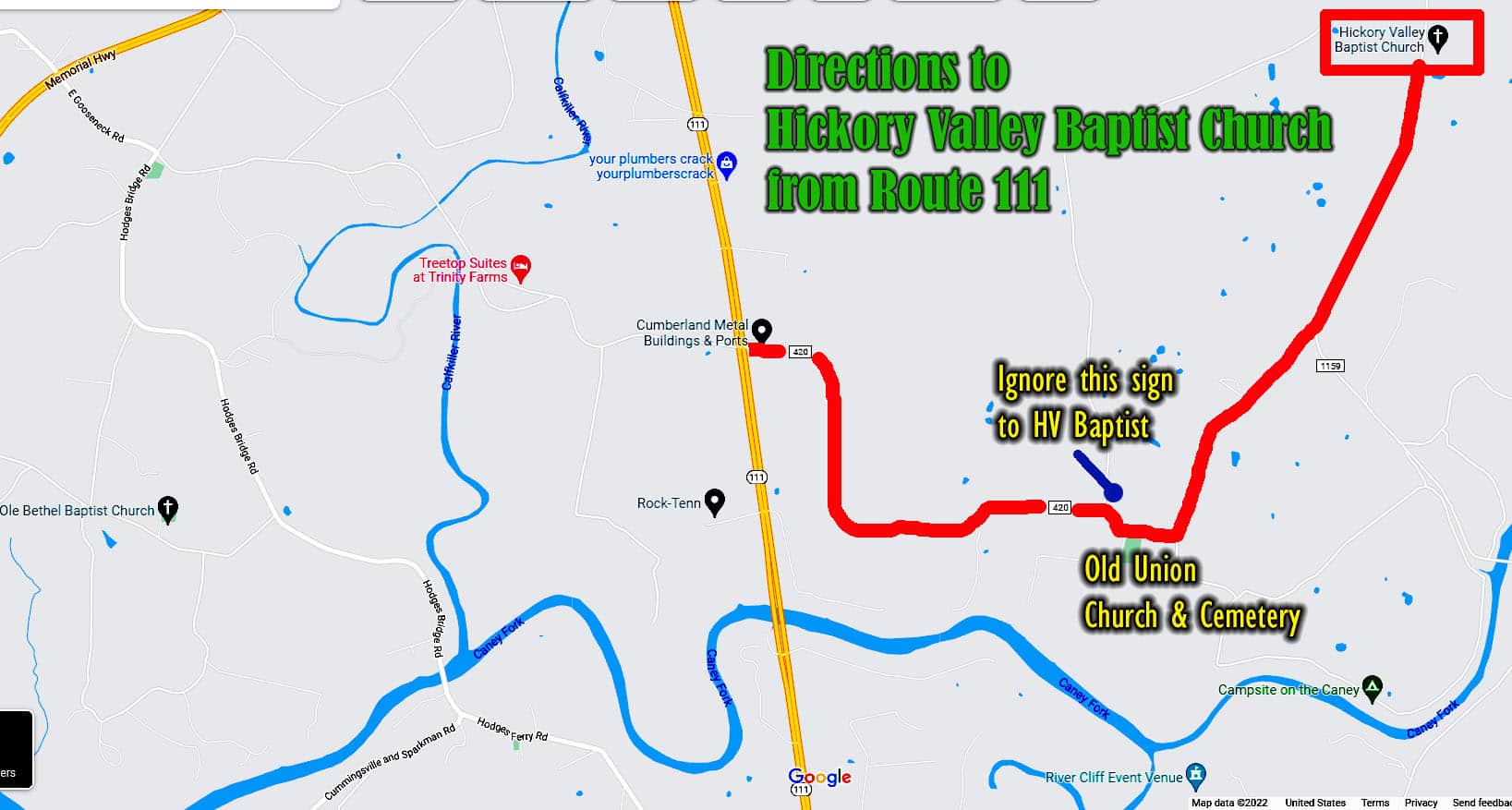
Additional Information
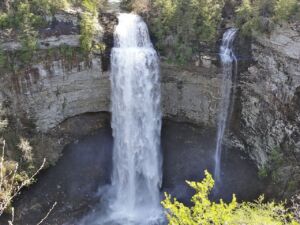
Some Lodging Options and Recreation Sites
Some Lodging Options and Recreational Sites For the July 22-23, 2022 Heritage of Daniel Haston Days Week Lodging and Recreation Reservations for lodging at these recreational sites tend to fill up EARLY, plan well ahead if possible. Fall Creek Falls State Park Fall Creek Falls State Park is one of Tennessee’s largest and most visited state parks. The park encompasses more than 29,800 acres sprawled across the eastern top of the rugged Cumberland Plateau. Laced with cascades, gorges, waterfalls, streams and lush stands of virgin hardwood timber, the park beckons those who enjoy nature at her finest. Fall Creek Falls,
Please share this information with others who might be interested.

15 – The “Black Madonna” in the Einsiedeln Monastery

15 - Einsiedeln Abbey, Home of the Swiss "Black Madonna"
Tuesday, June 20, 2023, our Hiestand-Haston tour group will visit the largest church in Switzerland–the famous Einsiedeln Abbey.
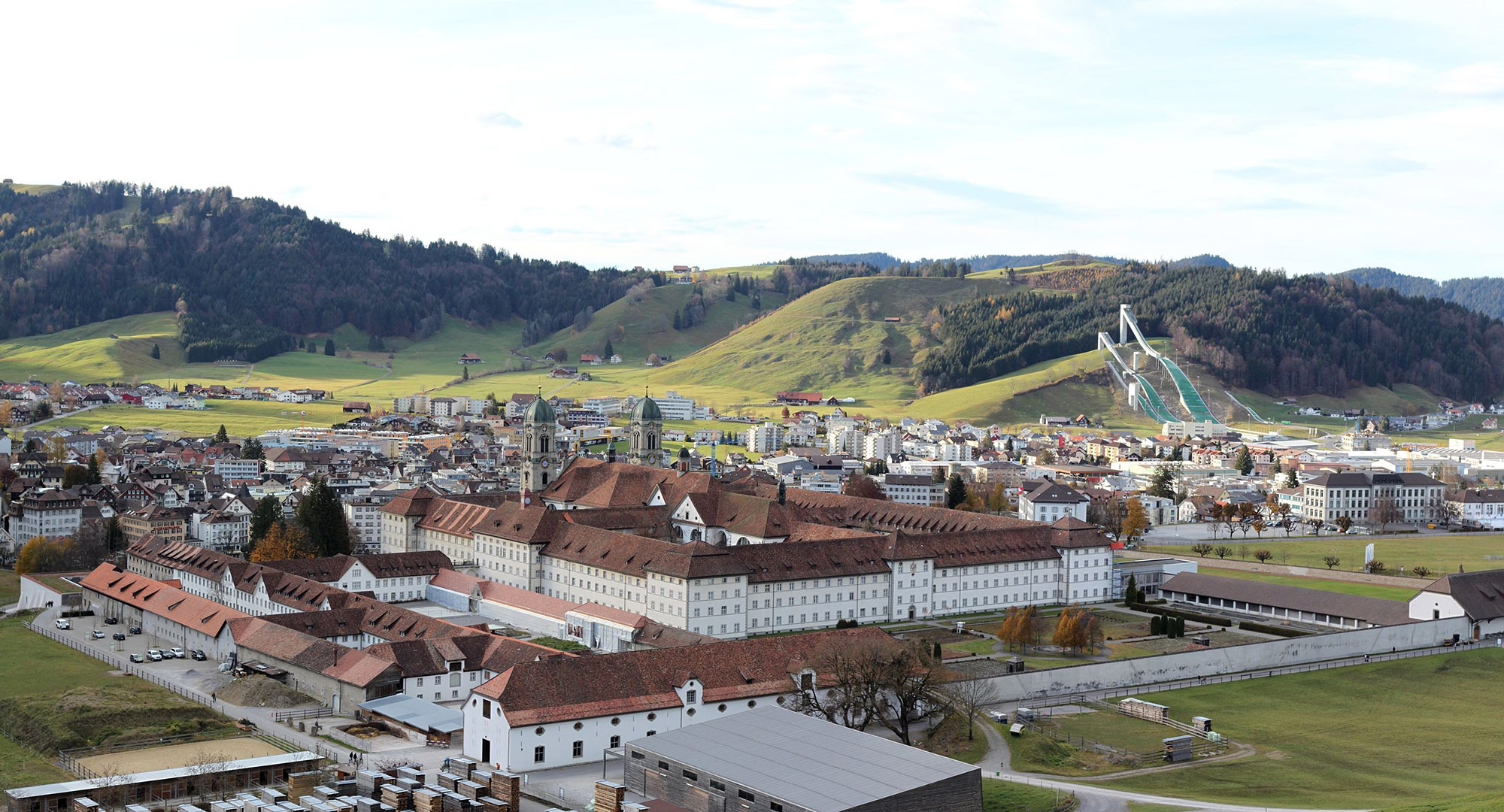
150,000 to 200,000 Roman Catholic pilgrims visit each year

The abbey is dedicated to Our Lady of the Hermits, the title being derived from the circumstances of its foundation, for the first inhabitant of the region was Saint Meinrad, a hermit. It has been a major resting point on the Way of St. James for centuries.
Meinrad was educated under his kinsmen, Abbots Hatto and Erlebald, at the abbey school at Reichenau, an island on Lake Constance, where he became a monk and was ordained a priest. After some years at Reichenau, and at a dependent priory on Lake Zurich, he embraced a heremitical life and established his hermitage on the slopes of mount Etzel. He died on January 21, 861, at the hands of two robbers who thought that the hermit had some precious treasures, but during the next 80 years, the place was never without one or more hermits emulating Meinrad’s example. One of them, named Eberhard, previously Provost of Strassburg, in 934 erected a monastery and church there, of which he became first abbot.
The church is alleged to have been miraculously consecrated, so the legend runs, in 948, by Christ himself assisted by the Four Evangelists, St. Peter, and St. Gregory the Great. This event was investigated and confirmed by Pope Leo VIII and subsequently ratified by many of his successors, the last ratification being by Pope Pius VI in 1793, who confirmed the acts of all his predecessors.
During the Middle Ages, Einsiedeln became a popular place of pilgrimage for people from southern Germany, Switzerland, and Alsace. Meinrad’s cell became the shrine of the Black Madonna of Einsiedeln. Over the years dust and the smoke of candles, oil lamps, and incense darkened the image. In 1803 the hands and face were painted black. Wikipedia.
Swiss reformer Huldrych Zwingli stayed in Einsiedeln for two years, during which time he focused on church activities and personal studies, including Greek and Hebrew. Many of his reformation ideas began to germinate during those years prior to his move to Zürich to become the people’s priest of the Grossmünster church there.
History of the Einsiedoln Abbey (3:29)
If you appreciated this article, please share it with others who might also enjoy it.

July 26, 2024 – Tour of Daniel Haston Family Historic Sites
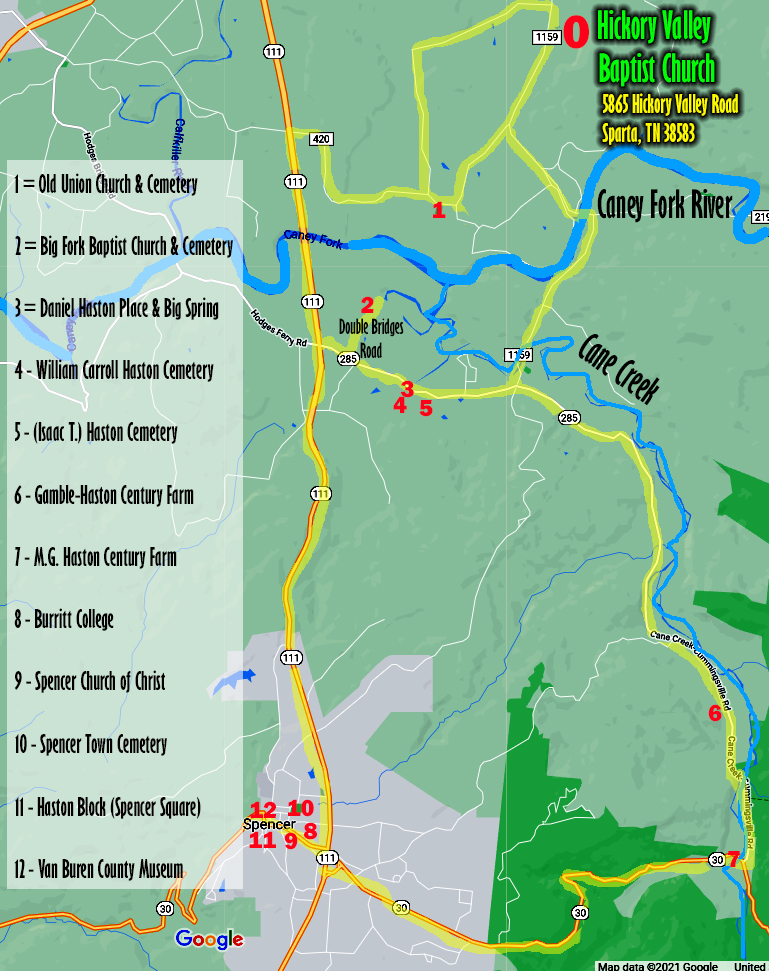
2024 Daniel Haston Family Historic Sites Tour
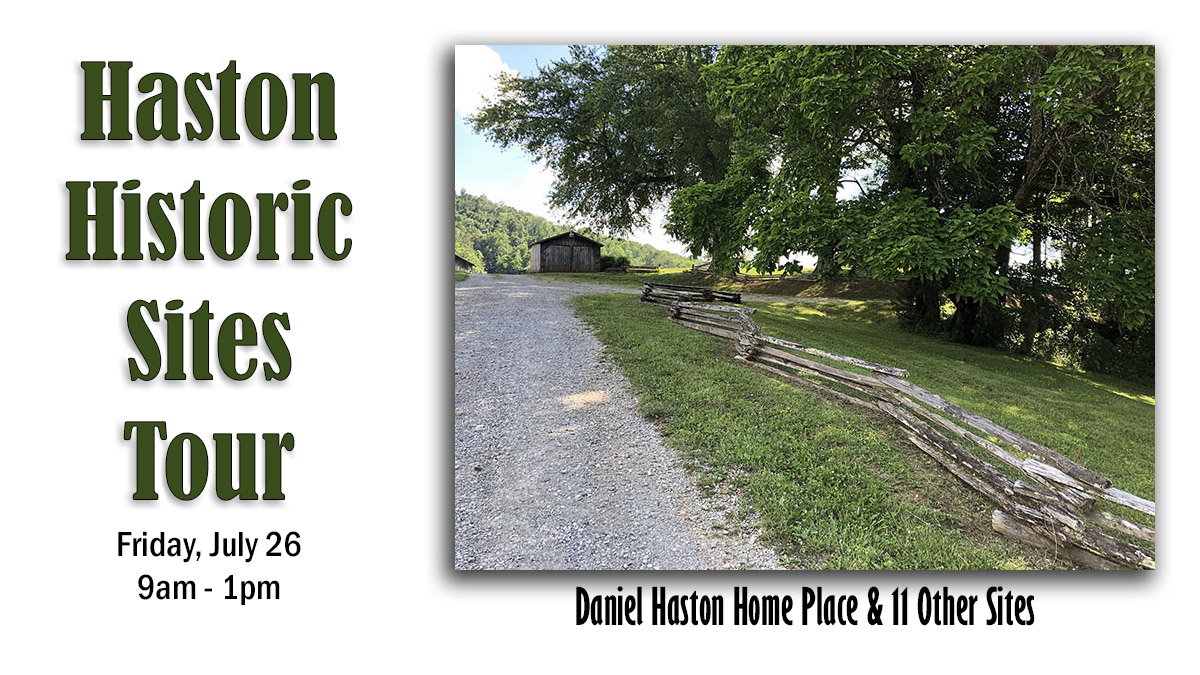
Friday Morning, Load the Bus at 9:00 a.m., July 26, 2024
At Hickory Valley Baptist Church


To see the highlighted route on a printed copy,
print in color or print in grayscale then highlight the route manually.
Click on the (right side) arrow to sequence through the sites on the tour.

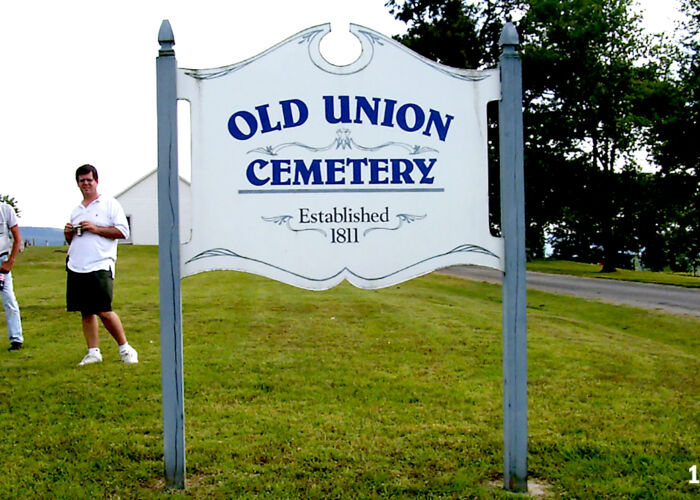

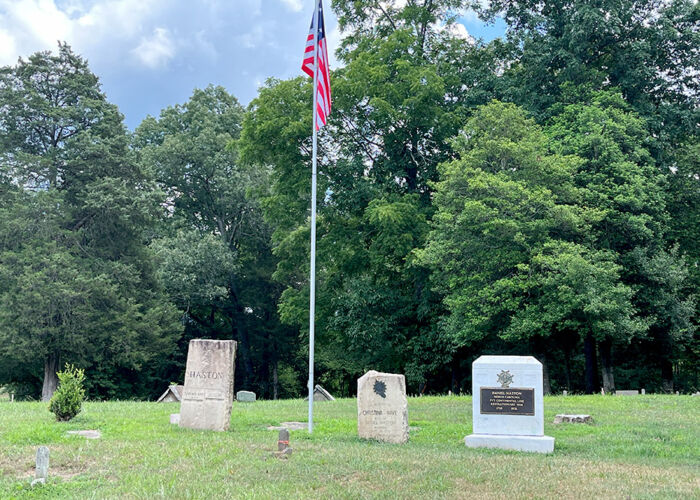
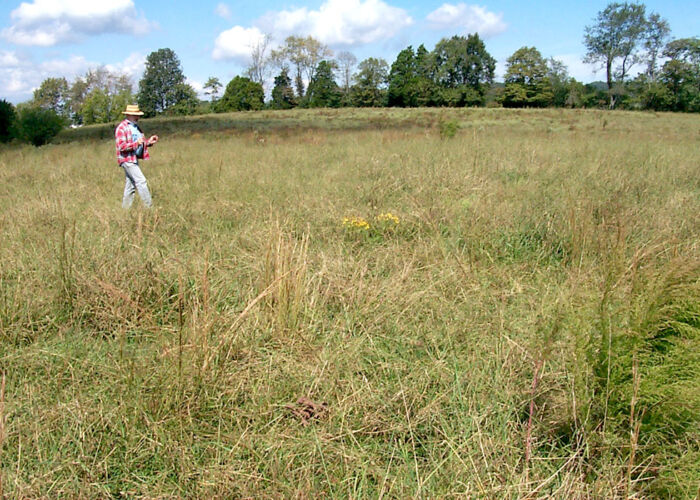
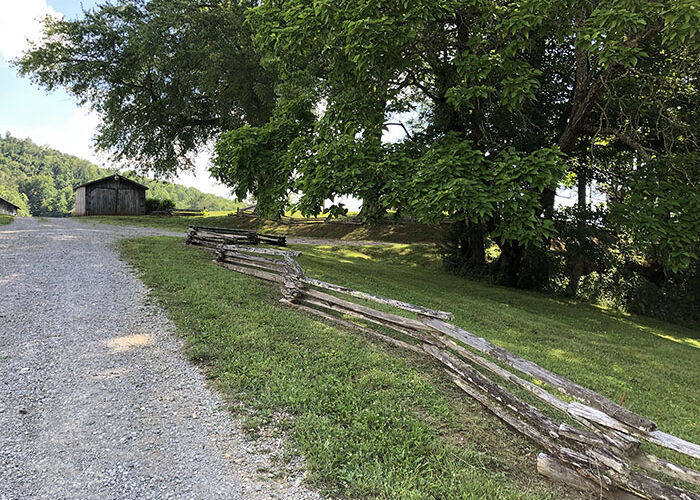
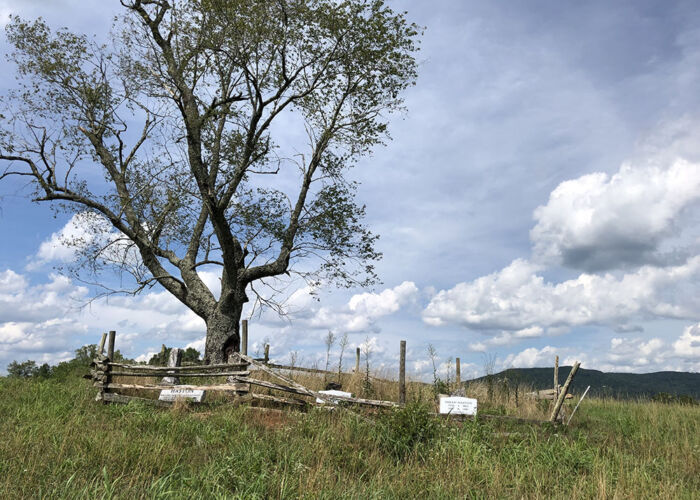
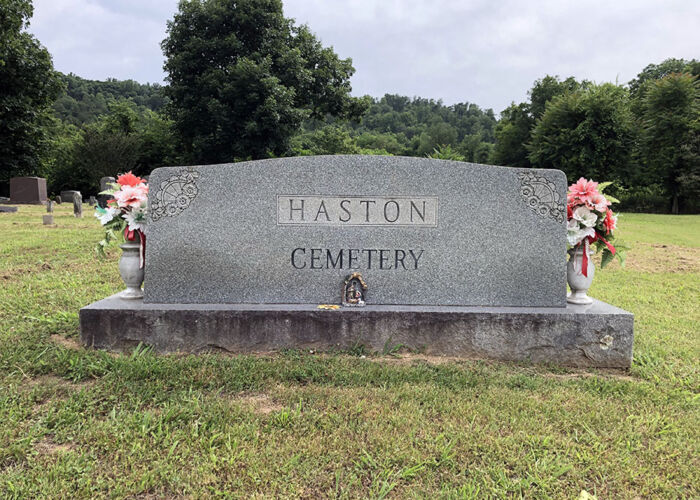
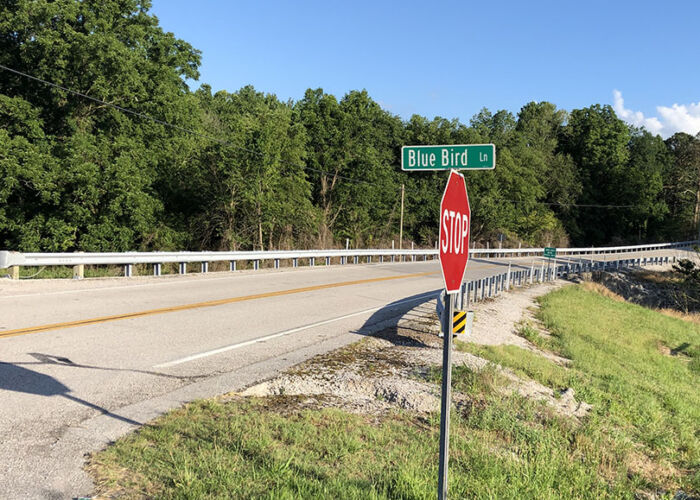
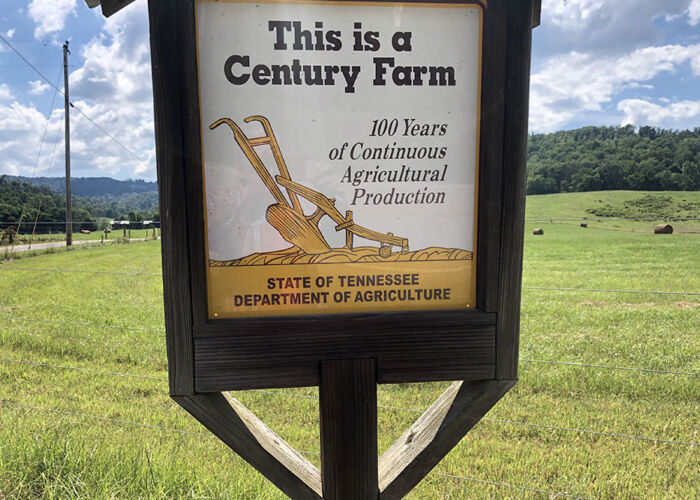
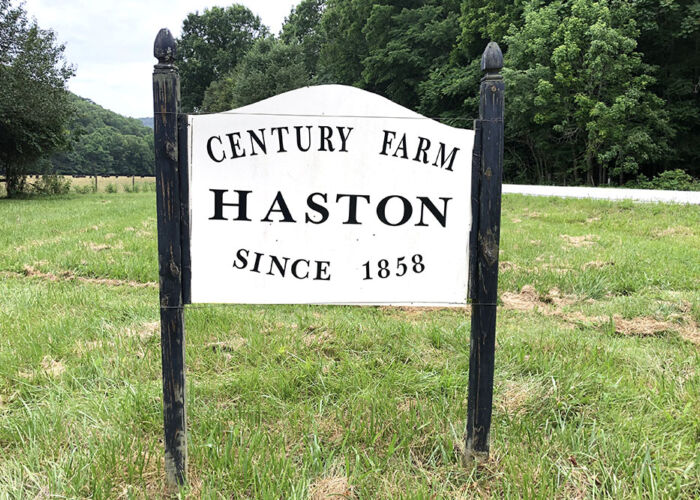
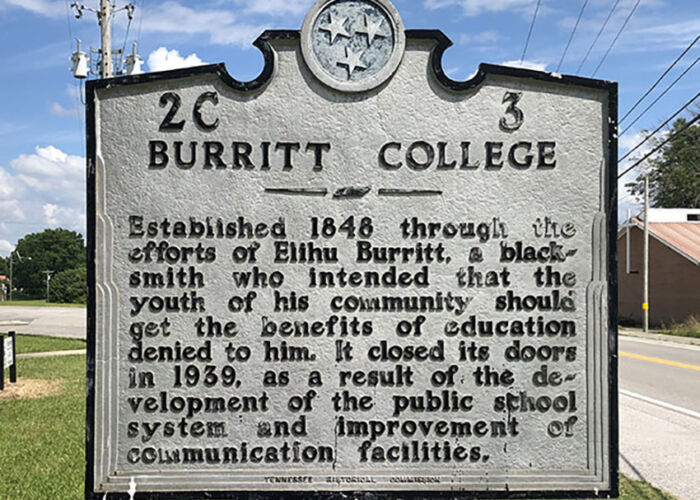

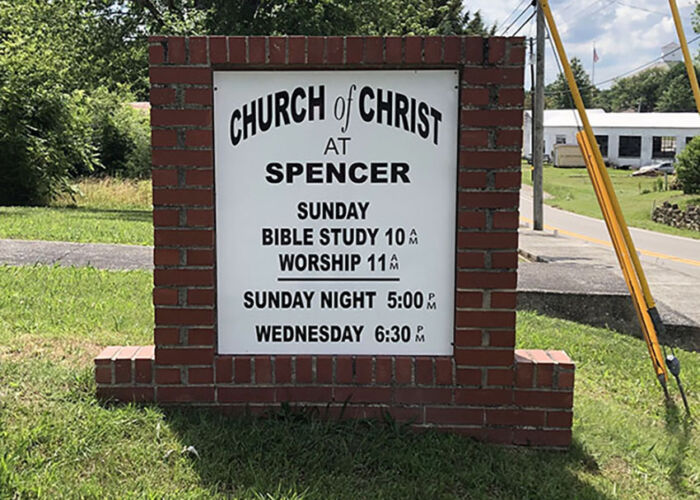

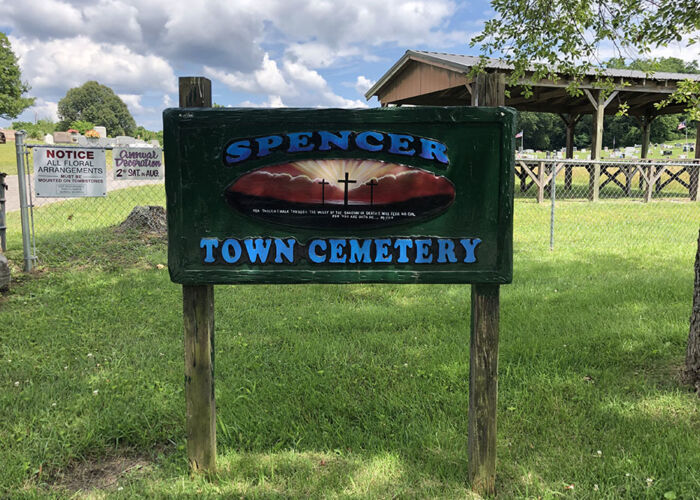
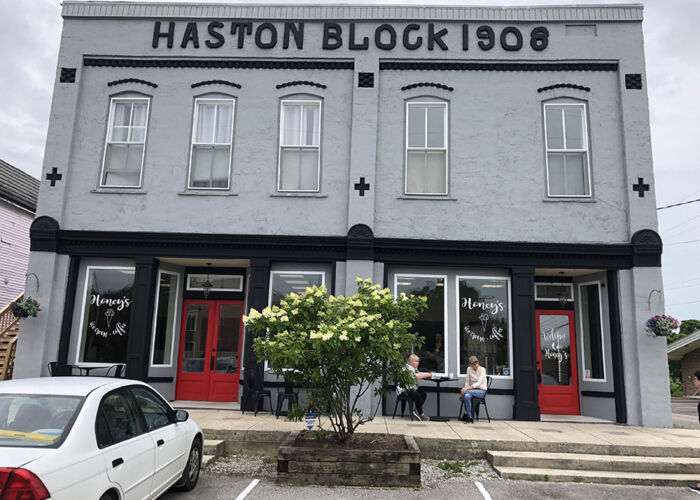

If this information was helpful, please share it with others who might also need it.

Some Lodging Options and Recreation Sites

Some Lodging Options and Recreational Sites
For the July 22-23, 2022 Heritage of Daniel Haston Days Week
Lodging and Recreation
Reservations for lodging at these recreational sites tend to fill up EARLY, plan well ahead if possible.
Fall Creek Falls State Park

Fall Creek Falls State Park is one of Tennessee’s largest and most visited state parks. The park encompasses more than 29,800 acres sprawled across the eastern top of the rugged Cumberland Plateau. Laced with cascades, gorges, waterfalls, streams and lush stands of virgin hardwood timber, the park beckons those who enjoy nature at her finest. Fall Creek Falls, at 256 feet, is one of the highest waterfalls in the eastern United States. Other waterfalls within the park include Piney Falls, Cane Creek Falls, and Cane Creek Cascades. Best for sight-seeing.
Very important to make lodging reservations as early as possible.
19.7 miles to Hickory Valley Baptist Church, 5865 Hickory Valley Road, Sparta, TN 38583.
Rock Island State Park

Rock Island State Park is an 883-acre park located on the headwaters of Center Hill Lake at the confluence of the Caney Fork, Collins and Rocky Rivers. The rugged beauty of the park includes the Caney Fork Gorge below Great Falls Dam. These overlooks are some of the most scenic and significant along the Eastern Highland Rim. Great Falls is a 30-foot horseshoe cascading waterfall, located below the 19th-century cotton textile mill that it powered over 100 years ago. Rock Island became a Tennessee State Park in 1969. Nearest to Hickory Valley Church.
Very important to make lodging reservations as early as possible.
16.9 miles to Hickory Valley Baptist Church, 5865 Hickory Valley Road, Sparta, TN 38583.
Sligo Marina on Center Hill Lake
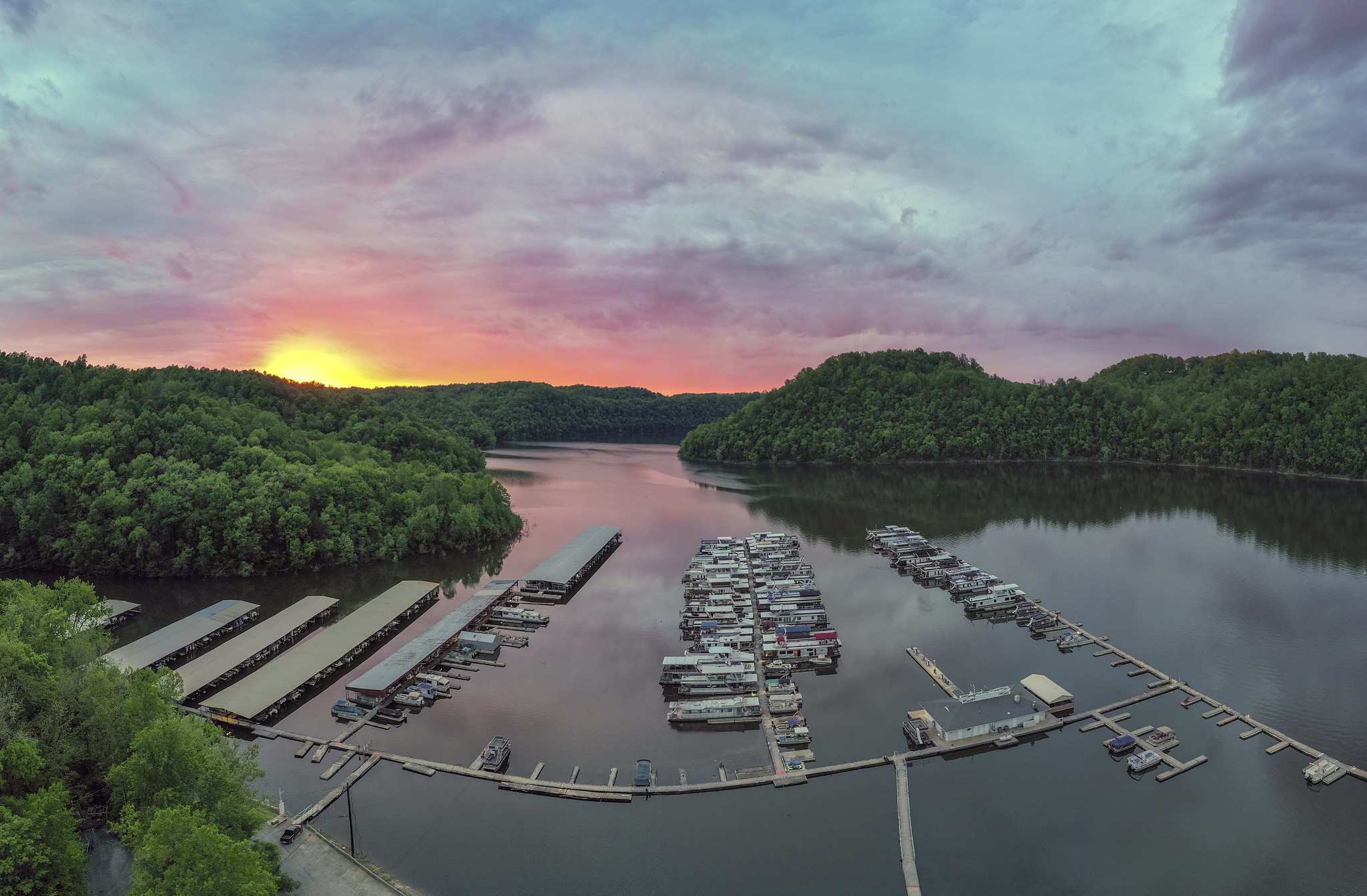
Sligo Marina has Pontoon Boats available for half-day and full-Day rental. Double deck pontoon boats include a slide and have a 14 person limit. If you are looking for a place to store your boat at Center Hill Lake Sligo Marina has multiple options available. Slips available include covered and uncovered and can accommodate boat sizes ranging from jet ski’s to large pontoon boats. Marina has a launch ramp and nightly tie-ups are available. Electricity and water are available. A rental cabin is a great way to spend the weekend at Center Hill Lake. The rustic rental cabins sleep six and include three full beds, two baths, kitchenette, and screened porch. The cabins overlook the lake and include a boat slip. The Sligo Ship’s Store carries most common items needed for a day on the lake. There is also a gas island for boat refueling. If you are hungry after a day on the water stop by the Wheelhouse Restaurant for a great meal. Best for serious fishing.
Very important to make lodging reservations as early as possible.
25.5 miles from Hickory Valley Baptist Church, 5865 Hickory Valley Road, Sparta, TN 38583.
Lodging Only
Vacation Rentals by Owner

Vrbo is an American vacation rental online marketplace originally known as Vacation Rentals by Owner or VRBO.
Very important to make lodging reservations as early as possible.
Firefly Acres
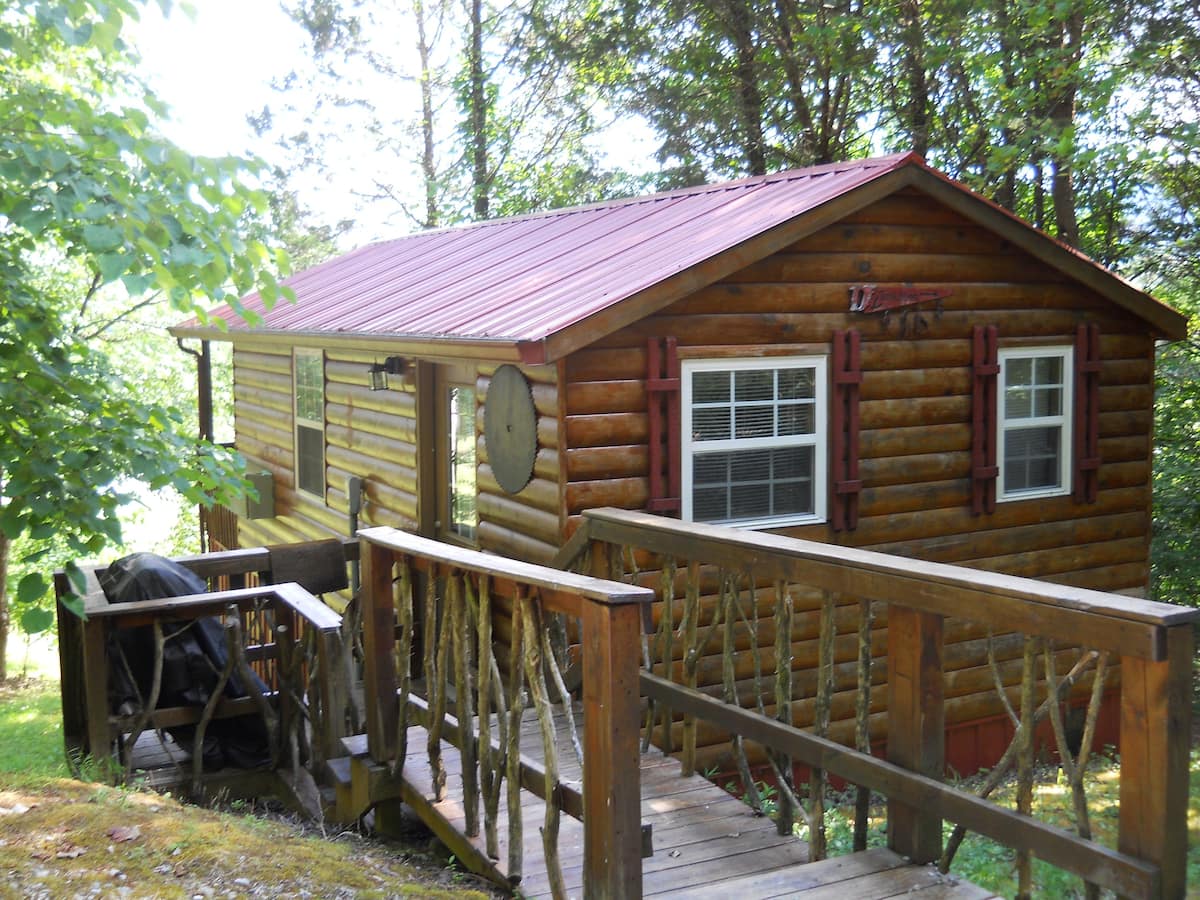
Only 4.8 miles from Hickory Valley Church and adjacent to the original Daniel Haston farm.
Firefly Acres! I can’t say enough about this hidden gem!
We were looking for a cabin to stay in while visiting the Falls Creek Falls State Park and found this wonderful place. There are 4 different cabins on this beautiful secluded horse ranch. We stayed in the Tool Shed. The décor was amazing with, unexpected gems everywhere you looked. It had super comfortable beds, a small kitchen, bath and a wonderful covered deck overlooking the horse pasture. If all that wasn’t enough, the Owners, Pete and Bambi were amazing! After a wonderful day hiking we called ahead and let them know we wanted to have a fire. When we returned, the fireplace in the pavilion was all ready to go, all we had to do was light it and enjoy! -A review by an unknown guest
Very important to make lodging reservations as early as possible.
Cookeville, TN Hotels

McMinnville, TN Hampton Inn

There is a Royal Inn in Sparta, but some of the reviews are not good.
If you know of others who might want this information, please pass this on to them.

29 – Resolving the “McComisky Mystery” in the Daniel Haston Family

29 - Resolving the "McComisky Mystery" in the Haston Family

A common piece of erroneous family lore has circulated among Daniel Haston family members for many years–the assumption that Daniel’s son, David, was named “David McComisky Haston.” You don’t have to look at many Haston family trees on Ancestry.com or other genealogy internet sites to see this assertion. That incorrect notion was probably fueled by the now-debunked theory that our Hastons were Scots-Irish. And some Haston folks have even incorrectly theorized that Daniel Haston must have married a McComisky woman at some point prior to the birth of his first son David.
But it is true that the McComisky name DOES appear in the early Haston family. David and Margaret/Peggy Roddy Haston named their fourth child (second son, born 1808) “Daniel Haston.” But the most interesting part of his name is the middle name: “McComisky” (or McComiskey, McCumskey, McCumskay, etc.). How and why did this McComisky surname enter the Daniel Haston family? In reading piles of correspondence between earlier Haston researchers, I have found that this was one of the most perplexing questions they sought (unsuccessfully) to answer.
“I am especially intrigued by the name of the fourth child of the first David.
I’ve wondered why he happened to be named Daniel McComisky [Haston].”[i]
“Every time we get to a research center…we include the name McComisky
in our search. So far, we have not found the name ….”[ii]
“…did you ever hear your dad say anything about how Daniel McComisky
[Haston] got his name? I am wondering about the McComisky ….”[iii]
[i] Source: Personal letter to Mr. and Mrs. Dave R. Haston of Sparta, Tennessee from Sybaline Haston Edwards of Bridge City, Tennessee, June 2, 1973.
[ii] Personal letter from Mrs. Dave R. Haston to Sybaline Haston Edwards, June 14, 1973.
[iii] Personal letter from Mr. and Mrs. Dave R. Haston of Sparta, Tennessee to Maude ____, September 17, 1973.
The Clue that Unlocked the Mystery
Early in August 2000, Sherry Mirkovic discovered a Baltimore County, Maryland will that was created by Daniel McComisky who lived in Maryland in the late 1700s. And this McComisky man had grandchildren in the Carolinas, which would have included Tennessee in September 1789, the time the will was created. Subsequent online searches located a genealogy forum post by Beth Layman that documented a connection between this Daniel McComisky and a Philip Roddy family. Philip Roddy lived in Randolph County, North Carolinas in the 1770s through the very early 1790s, then lived in East Tennessee in the 1790s and early 1800s. That information led to Beth Layman’s book, Richard Green Waterhouse (1775-1827): Tennessee Pioneer, which added more details regarding this Knox County, Tennessee Roddy family and its connection to the Daniel McComesky family of Baltimore County, Maryland. As it turned out, Philip Roddy married a daughter of Daniel McComisky–her name was Mary McComiskey Roddy.
We also learned that the Philip Roddy family was living near our Daniel Haston in Knox County, TN shortly before and after the turn of the 19th century–about 1795-1803. And we learned that David Haston’s wife, Margaret (Peggy) Roddy was almost certainly the daughter of Philip and Mary McComisky Roddy.
Bingo!
Daniel’s grandson was named Daniel McComisky Haston. The middle name came from his grandmother’s family, Mary McComisky (Roddy), daughter of Baltimore County, Maryland’s Daniel McComisky. And Daniel Haston’s son, David Haston, was NOT named “David McComisky Haston!” So, please correct your genealogy records if you have copied this erroneous assumption.
Location of Daniel McComisky's 447 Acres in Baltimore County, Maryland
If you appreciated this article, please share it with others who might also enjoy it.

13 – Village of Hirzel, Home of Two Famous People

13 - Village of Hirzel, Switzerland - Home of Two Famous People
Our June 2023 Hiestand-Haston tour group will visit the little mountain village of Hirzel, Switzerland on Monday, June 19.

The village of Hirzel, just a few miles on the mountainside southwest of Richterswil is famous for its beauty, as well as the homes of two extraordinary Swiss people. Johanna Spyri, the author of Heidi, is known internationally. Hans Landis is famously known as a great hero of Swiss Anabaptist/Mennonite descendants. Landis was the last Anabaptist martyred for his Christian faith.
Johanna Spyri - Author of Heidi
Hans Landis - The Last Swiss Anabaptist Martyr
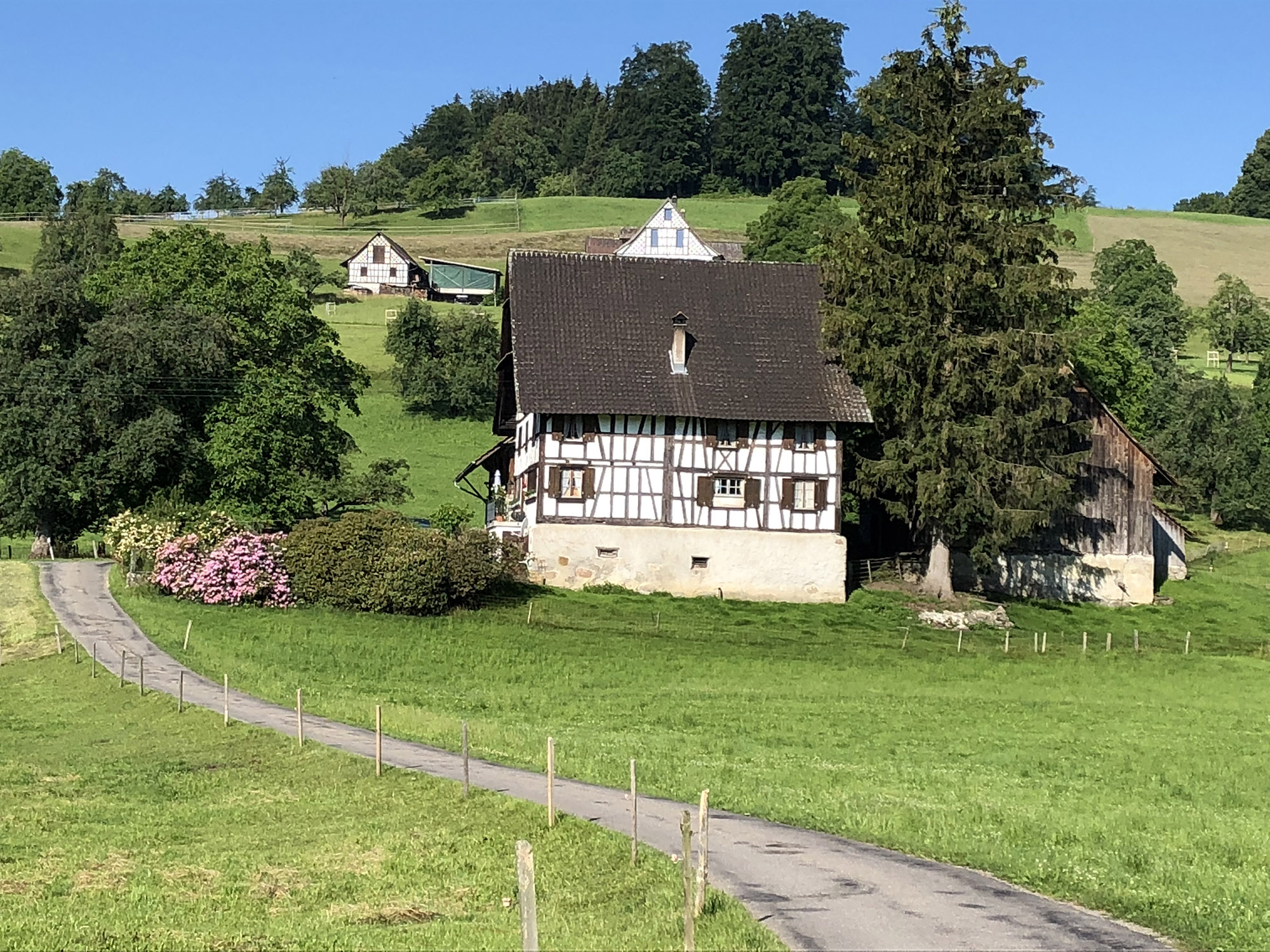
Hans “The Martyr” Landis was a notable Anabaptist and was probably the most famous Landis. He gained notoriety by being the last martyr in Switzerland to be executed for his religious beliefs. “In the Ausbund, (oldest hymnbook of the Swiss Brethren ) No. 132, is a song of 46 stanzas commemorating his death.
After several imprisonments and escapes Hans was imprisoned in the Wellenberg tower which stood in the Limmat River in Zurich, Switzerland. The the tower is where the Swiss authorities decapitated Landis on September 30, 1614, for his leadership of the “heretical” Anabaptists and his refusal to leave his congregation.
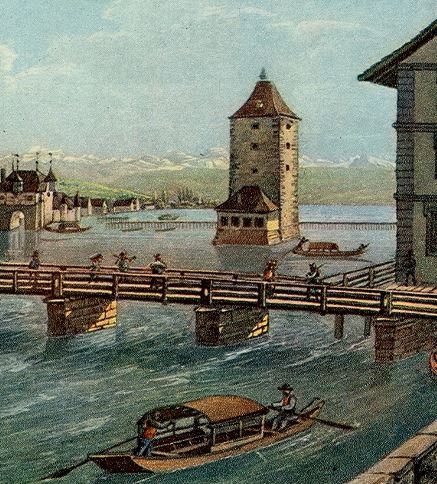
Our Hiestand Anabaptist ancestors were probably associated with Hans Landis.
He may have been considered to have been their pastor.
See the location of Hirzel in relation to Richterswil and Wadenswil.
Lone Linden Trees on the Hills of Hirzel
Legend has it that the farmers on Hirzel sold their souls to the devil in return for more land. The devil took the easy way out and just pushed the earth up from inside. When the farmers realised the extra land was steep and of no great use, they felt cheated on and planted a linden tree on top of every hill. With the linden trees, being the “trees of love,“ the devil would avoid the area in the future.
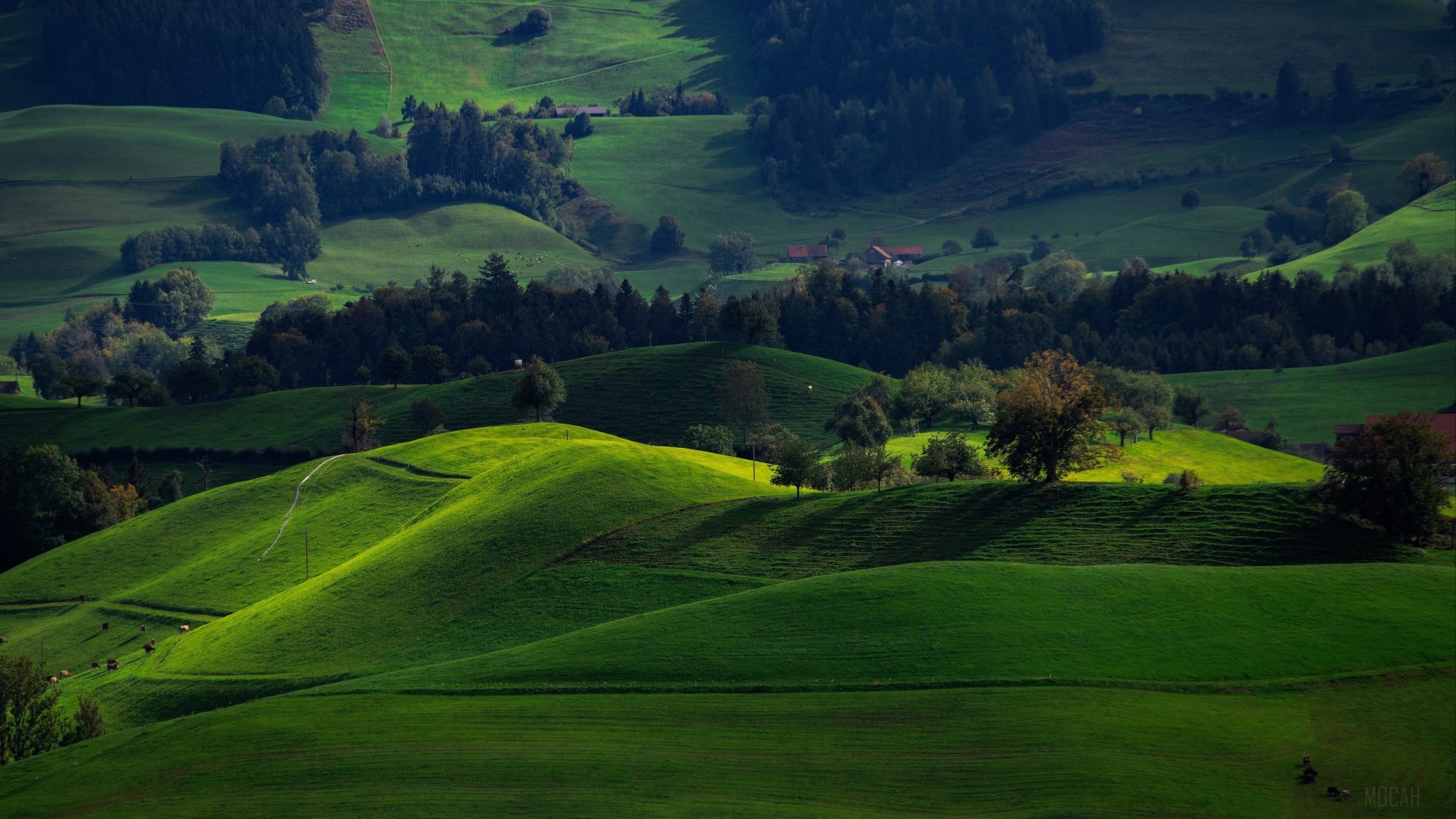
Share this with Hastons or related family members who might be interested in the June 14-27, 2023 Hiestand-Haston European Heritage Tour.

28 – David and Peggy Haston on Grassy Creek in Knox County, TN

28 - David Haston - Distinguishes Himself as a Young Adult
Adjacent to a 2020 $45 Million Development Project
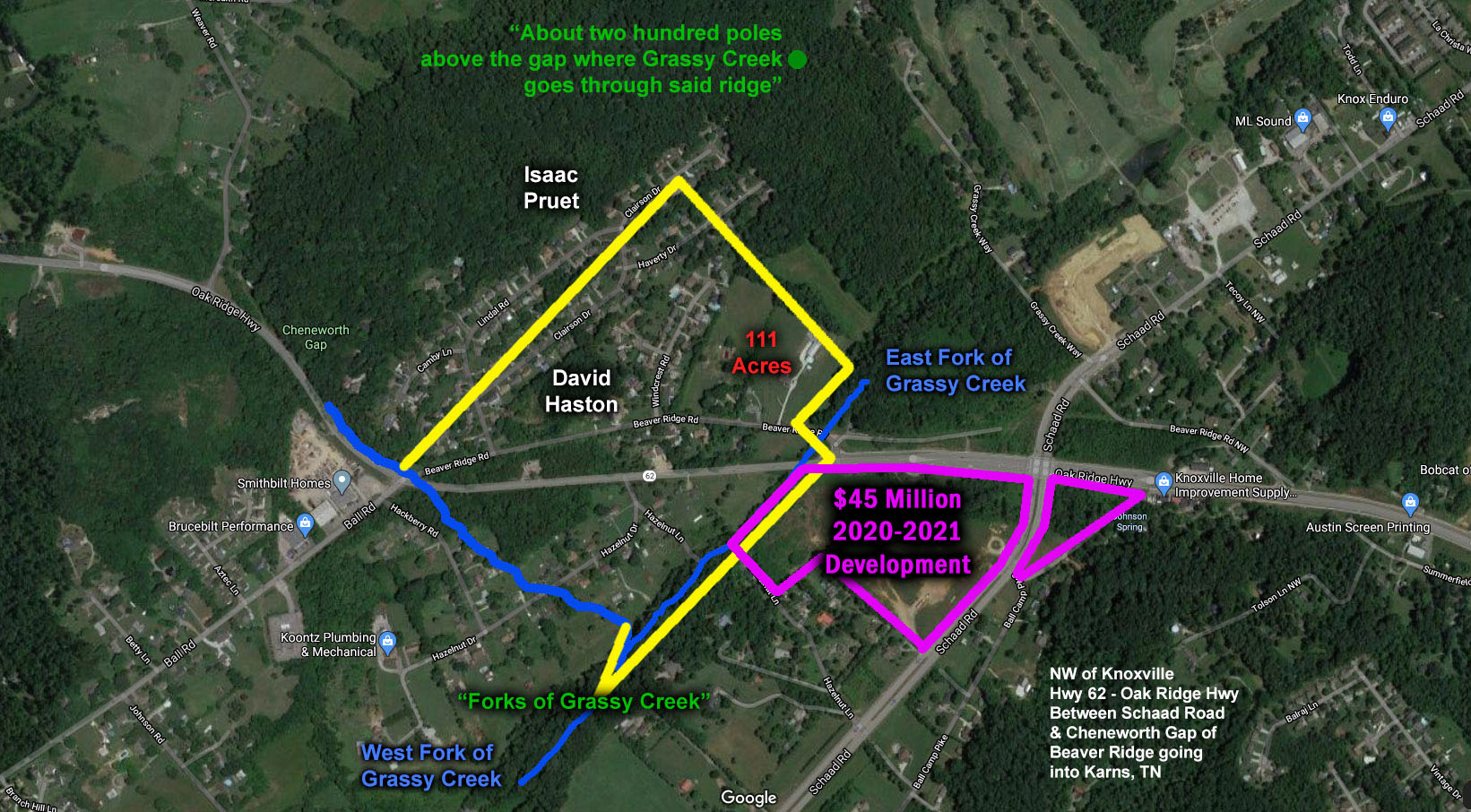
At age 25, David Haston became the owner of 111 acres in Knox County, TN. Apparently, owning land was not something his father (Daniel) achieved until his mid-50s. In 2020, a $45 million project was developed southeast of the property David owned in 1802-1806. In fact, the Grassy Creek Shopping Center overlaps David and Peggy’s property.
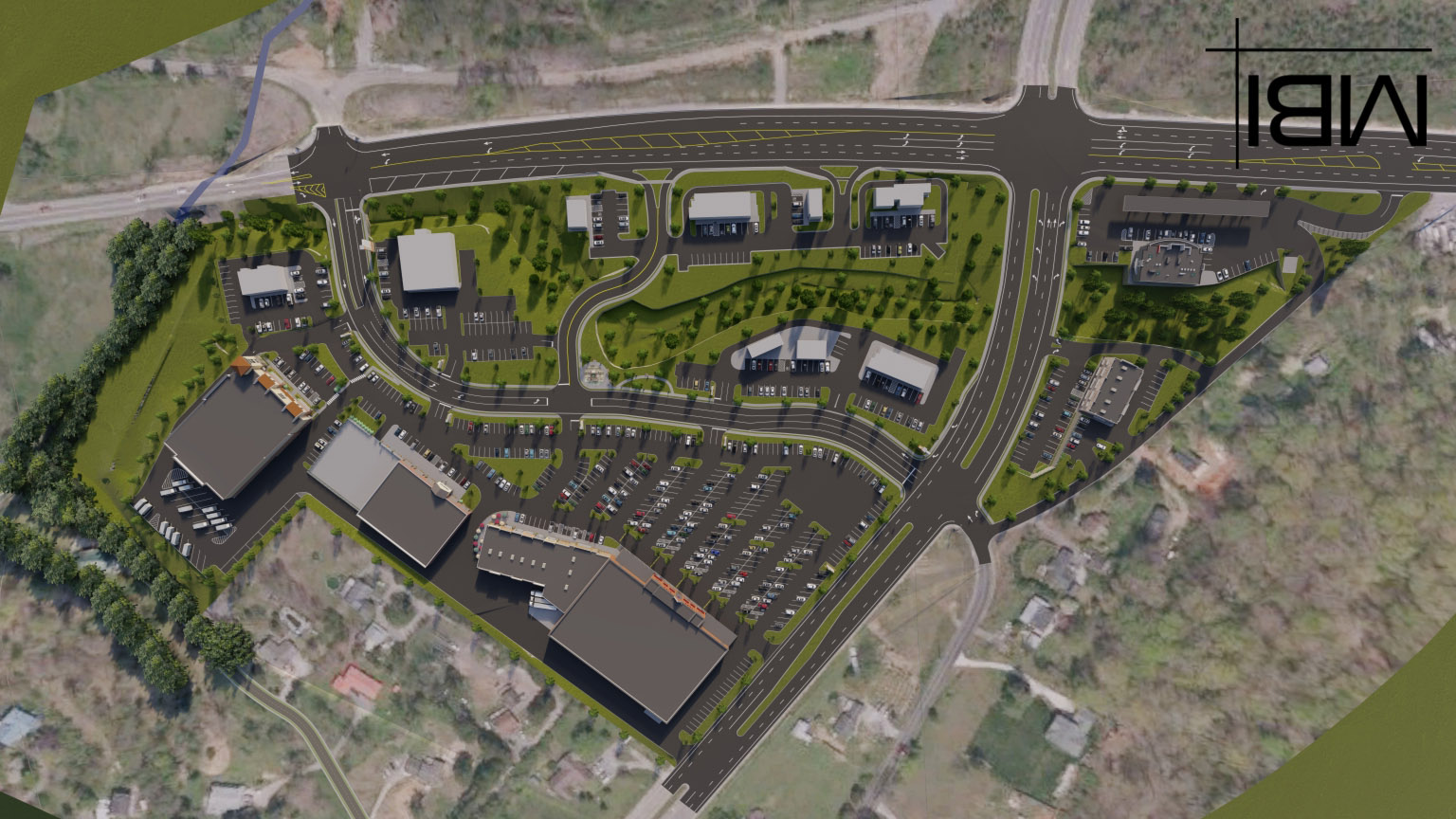
I’m not sure what the difference was, but David Haston stood out among Daniel’s sons. He apparently was fairly well educated for a young man who grew up in a poor German-speaking family. Like all of Daniel’s children, he undoubtedly was able to speak English and German. And somewhere along the way he received a decent education for his time and place. It’s only a guess on my part, but my theory is that he someway managed to be associated with some of the prominent people in Knoxville–perhaps even the earliest political and civic leaders in the little pioneer town that happened to be the capital of Tennessee. Maybe he served as an aide to some of them–I don’t know. But later, when he got to White County, Tennessee, he demonstrated civic leadership and land ownership–as well as lay leadership in the local Cumberland Presbyterian Church. And in Knox County, he was the owner of 111 acres–with a creek flowing through his property–at the age of 25
September 1, 1801 – David and Peggy’s first child, Malinda, was born on this date somewhere in Knox County.
October 28, 1802 – Where did David and Peggy live the first couple of years of their marriage? With David’s family? With Peggy’s family? Did they lease one of the Charter lots and live there or rent a place in Knoxville? We will probably never know. But for a young man from a poor family, David must have been quite industrious. About two and a half years after he married, David became an owner of 111 acres on Grassy Creek, northwest of Knoxville.
David purchased 111 acres from John Armstrong for $300 on this date. The tract of land was located on the east fork of Grassy Creek in Hinds Valley, between Beaver Ridge and Blackoak (Black Oak) Ridge, about eight miles north west of Knoxville.[i] Grassy Creek runs in a southwest direction on the west side of and parallel with Schaad Road through the Knoxville Golf Course, crosses Oak Ridge Highway (Route 62) and then is joined by other streams as it turns northwest and flows through the Cheneworth Gap of Beaver Ridge and meanders from there into Beaver Creek, a tributary of Clinch River.
[i] Knox County, Tennessee Real Estate Purchase, Original Book K, 79; Volume C, Volume 1, 300-301.
1803 – The name David Hasston appeared on an 1803 Knox County tax list. He owned 111 acres on Grassey (Grassy) Creek and his household had one white poll. He was in the Captain Childs (Chiles) Company.[i] When the earliest settlers moved to that area, they found an abundance of tall grass “higher than a man’s head” in the valleys all the way to the foot of Clinch Mountain.”[i]
[i] Nannie Lee Hicks, The John Adair Section of Knox County, Tennessee. (Knoxville, TN: The Nocturne Garden Club, 1968), 12.
[i] “Captain Childs Company,” Knox County, Tennessee 1803 Tax List.
January 22, 1804 – This was the birthdate of David and Peggy’s second child, Mary (“Polly”).
Mid-1805 – Sometime between the January and October Knox County Court terms, David Haston was an auctioneer for the estate sale of Jacob Neff who had died in the latter part of 1804. Jacob Neff was a grandson of Dr. John Henry Neff who lived near the Hiestands in Virginia. He may have been a nephew of Christina Nave. If so, Jacob Neff and David Haston were first cousins. But Jacob Neff’s wife was a Strickler whose family was closely connected to the Hiestands.
June 11, 1806 – David and Peggy’s third child, Willie B., was born before they sold their Grassy Creek land and moved to White County. Willie’s middle initial apparently stood for Blount.
Willie (pronounced “Wiley”) Blount (born 1768) was a half-brother of William Blount, the former governor of the Southwest Territory. Willie studied law at the universities that later became Princeton and Columbia before serving as a private secretary for his brother, Governor Blount. At the time Willie B. Haston was born, Willie Blount was living in Montgomery County, in north central Tennessee. “Blount was elected governor in 1809 and then reelected in 1811 and 1813.”[i] He was Governor of Tennessee during the War of 1812.
[i] Anne-Leslie Owens, “Willie Blount,” Tennessee Encyclopedia, accessed October 6, 2019, https://tennesseeencyclopedia.net/entries/willie-blount/.
To name a son after a popular politician was not unusual, but Willie Blount was not yet governor of Tennessee when David’s first son was born. David Haston and Willie Blount lived in Knoxville for several years at the same time, which makes me wonder if David had some special connection with the future governor of Tennessee—special enough that David named his first-born son Willie Blount Haston.
September 11, 1806 – On this day, one day before White County was officially formed from Smith and Jackson Counties, David sold his Grassy Creek land in Knox County. David bought the land for $300 in October of 1802 and sold it for $490 in September of 1806, a 63% increase in price in four years.
November 11, 1806 – The Jacob Neff estate was settled on this date. Sometime prior to then, David Haston had been paid (by receipt) $1.00 for his part in the estate settlement. But, by the time the estate was settled, David had already received his payment and may have been on the way to or in White County.
If you appreciated this article, please share it with others who might also enjoy it.

12 – The Richterswil Museum (Canton Zurich, Switzerland)
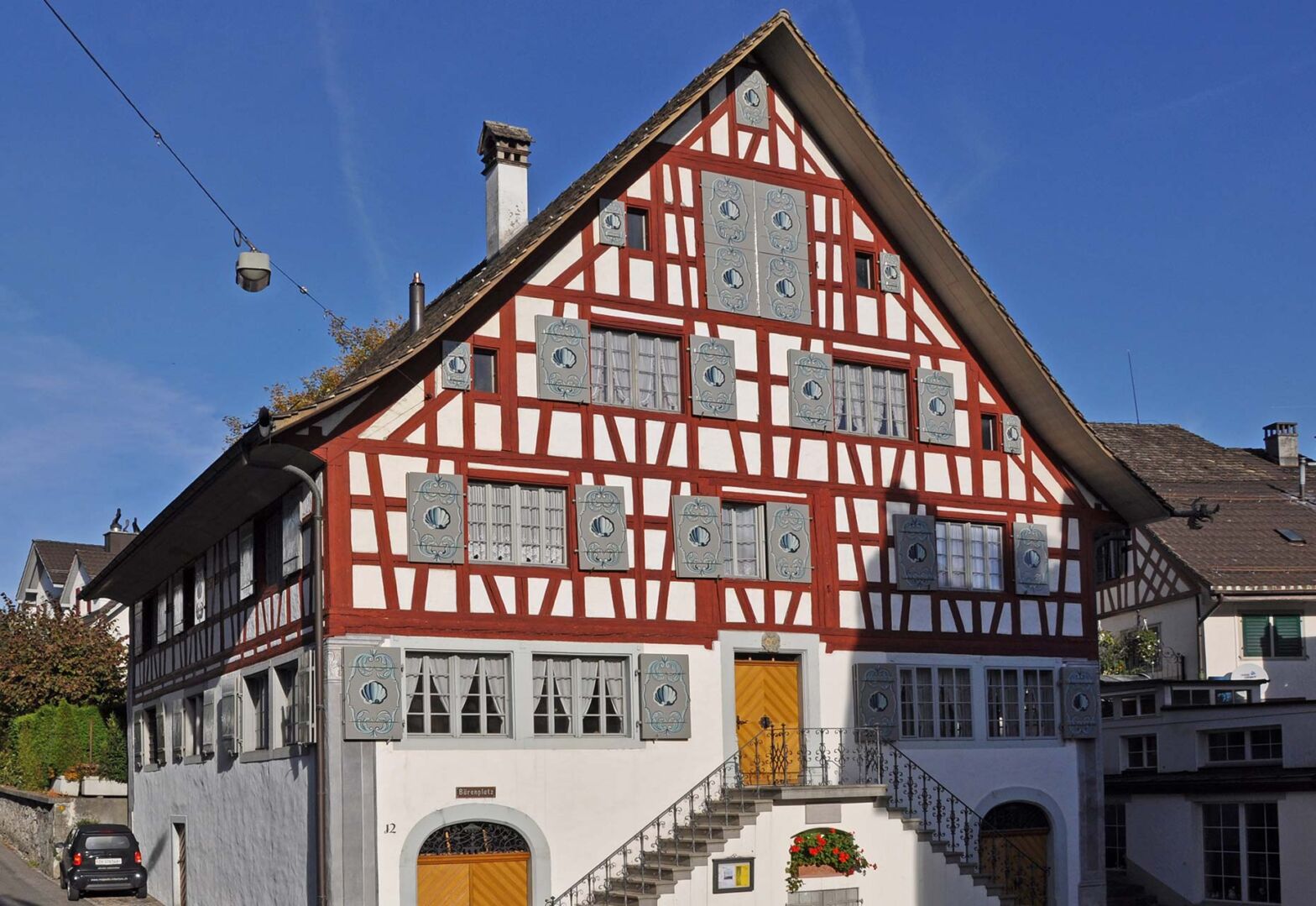
The Richterswil Museum (Ortsmuseum Richterswil)

The Richterswil local museum deepens the understanding of regional history and promotes cultural life in the community.
The main points of their work are:
- Management and expansion of the historical collection that is housed in the Haus zum Bären.
- The organization of exhibitions showing part of the local history.
- The publication of historical writings.
- The organization of exhibitions in the field of art and culture in general.
The Richterswil local museum in the venerable “Haus zum Bären”, a stand construction from 1749, has a treasure trove of drawings and engravings from the 18th and 19th century, the age of tourism in the village. Old films, reports, pictures and photographs document the heyday of industry, industrialists, workers, manufacturing methods and village life. The museum houses the archive of the Zürichseezeitung from 1865. A pharmacy, a shoemaker’s workshop, a kitchen and music playback devices date from around 1900. Various very beautiful rooms are rented out for various occasions and exhibitions. Opened in 1975
The museum is located in downtown Richterswil, one of the earliest villages where our Hiestands lived. Contact them ahead of your trip to schedule a visit, since their normal hours are limited. They have always been very flexible with us and have some Hiestand materials that you will want to see.

27 – David Haston Marries 14-Year-Old Girl

27 - David Haston Married 14 Year Old "Peggy" Roddy
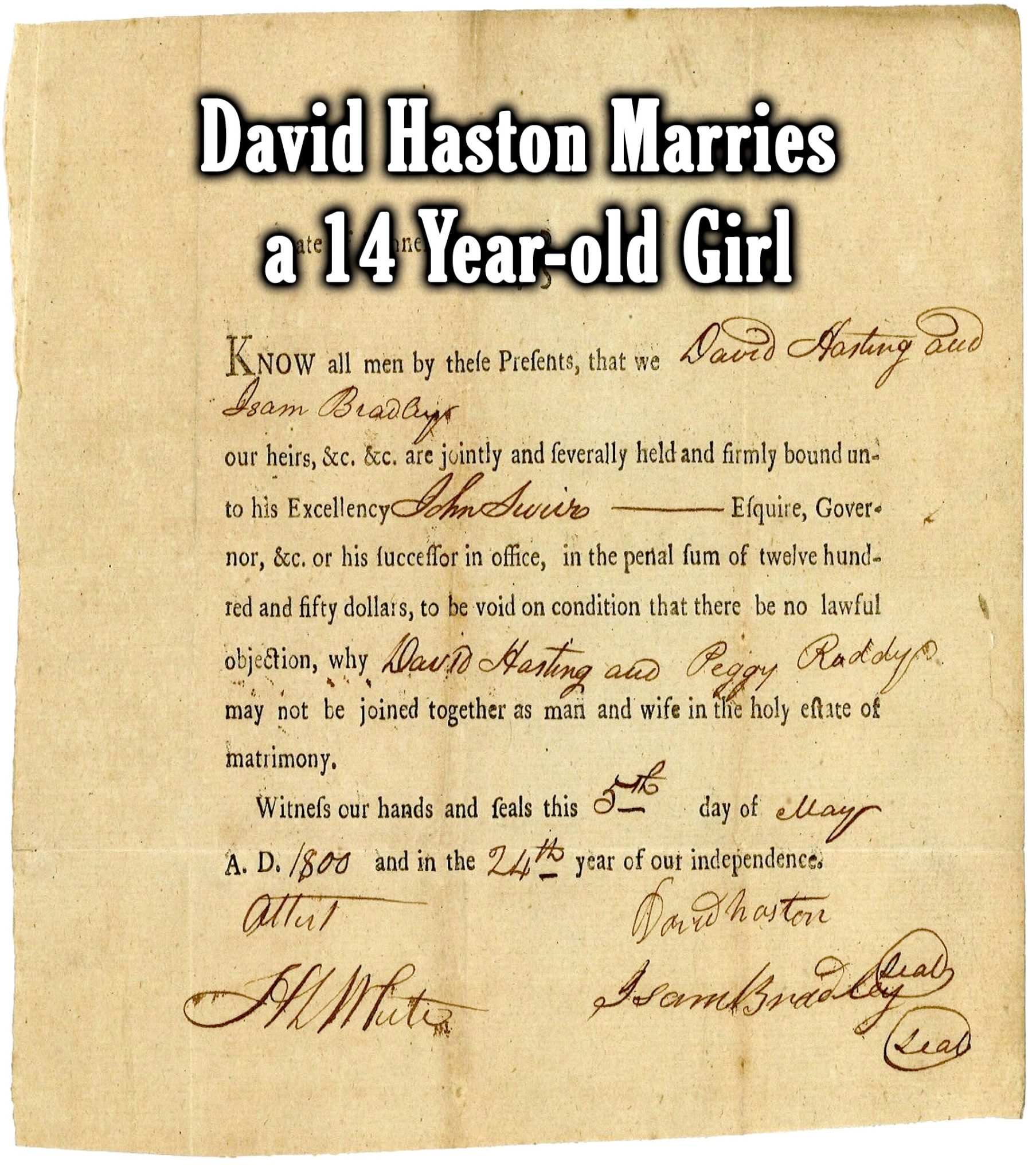
Yeah, I just created the title for the dramatic effect, but it was true. On May 5, 1800 (one day short of David Haston’s 23rd birthday) he was issued a marriage bond to marry Margaret “Peggy” Roddy in Knox County, Tennessee. Perhaps his bride was his 23rd birthday gift to himself, since the actual marriage often occurred a day after the bond was issued.
As you probably know by now, David Haston was Daniel’s oldest son. He was born in Shenandoah County, VA, probably up in Powell’s Fort Valley in the Massanutten Mountain where Daniel’s family lived for the first several years after his marriage to Christina Nave.
David’s bondsman for his marriage was Isham Bradley. As far as I can tell there was no familial relationship to Isham. He and David were probably just best buddies. David had been the bondsman for Isham Bradley’s wedding two years earlier to Susanna Matlock. And Isham Bradley followed the Hastons to Middle Tennessee a few years later.
Now, back to David Haston’s bride–Margaret “Peggy” Roddy. Yes, she was only 14 1/2 years old when she married 23 year old David! “Was that legal?,” you ask. Yes, in fact there was no legal statue regarding marriage ages in Tennessee until 1899! “Was that normal?,” you ask. Well, it wasn’t unusual. Men generally didn’t marry until they were old enough to establish themselves with a place to live and a job of some sort. And it was very common for girls to marry in their early teens. Anyway–it worked out fine because David and Peggy seem to have had a very good marriage, had 13 kids, raised some of their grandkids, and lived together 57 years until she died in 1857. How many husbands and wives today stay together until “death do us part,” 57 years of living?
David and Peggy Roddy Haston are my Great-Great-Great Grandparents and I’m very proud of them!
Who were Peggy’s parents? For who-knows-how-many-years, Haston family researchers have tried to find the answer to that question and have often “guessed” incorrectly that she was the daughter of Colonel James Roddy who lived in Jefferson County, TN. Not so, no way!.
Do you remember the story of David Haston cutting the cow tails off Nathaniel Hays’s horned cows? Peggy Roddy was the sister of three of the Roddy kids who were called to testify against David. Those kids were the children of Philip and Mary McComiskey Roddy who lived near Daniel Haston’s family, “south of the Holston River, opposite Knoxville.”
There is so much I have learned about this Philip Roddy family over the past 20 years! But I’ll hold that until a couple of articles later. Stay tuned!
If you appreciated this article, please share it with others who might also enjoy it.

Haston Family History Overview

The Daniel Haston Family: A Historical Overview
The Story of the Daniel Hiestand/Haston Family

From the Mountains of Switzerland to the Rhineland of Germany to all across America
The Story of Daniel Haston’s SWISS Ancestors, His Life, and All of His Known Children in 50+ Segments

Zoom – Wayne’s Haston Reunion Presentation
Are You Interested in a Two-Part Series of Zoom Presentations in Which I Would Give the Haston History Presentation I Gave in the Recent Haston

Video Presentation – Daniel Haston Family Tree
Video Presentation – Daniel Haston’s Family Tree Wayne Haston presents the first-generation Daniel Haston Family Tree, with information on each of the nine known children
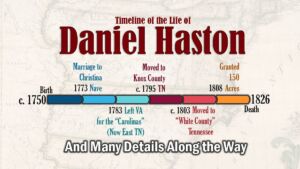
Timeline of Daniel Haston’s Life
Timeline of Daniel Haston’s Life – c. 1750-1826 The first 30 or so years of Daniel Hiestand’s life were spent in Virginia. The next (approximately)

The Story of the Daniel Haston Family – Book
The Book: The Story of the Daniel Haston Family Scroll Down to Order a Copy or Copies of the Book Remember the days of old; consider

The Centuries-Old Mystery of Daniel Haston’s Mother
Clues to the Identity of Daniel Haston’s Mother A Centuries-Old Mystery The family of Henrich Hiestand has been thoroughly researched for many years, but the
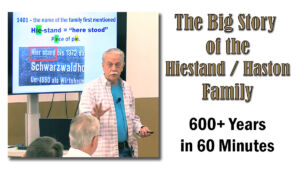
The Big Story of the Hiestand-Haston Family Video Presentation
Video Presentation – Haston History, 600+ Years in 60 Minutes Wayne Haston traces our Hiestand-Haston history from Switzerland, beginning in 1401 when the family name

Hastons – A Family of Early Tennessee Pioneers
The Daniel Haston Family – Pioneer Tennessee Settlers More Than a Decade Before Tennessee Became a State Daniel Haston was truly an American pioneer in

52 – Other Daughters of Daniel Haston?
52 – Daughter of Daniel Haston? One Yes, One Maybe, One No I am confident that Daniel Haston had two or three daughters (and/or maybe
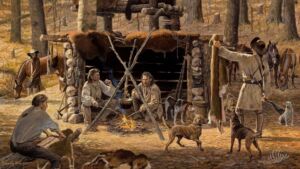
51 – Daniel Haston, Jr. Married into the Famous KY “Skaggs” Longhunters Family
51 – Daniel Haston, Jr. Married into the Famous KY Longhunters Skaggs Family Did you know that descendants of Daniel Haston, through his son Daniel,
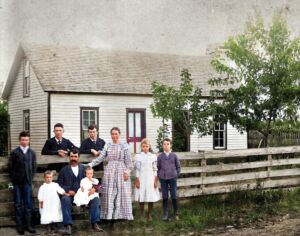
50 – Jeremiah Haston – Another Son of Daniel Goes to Missouri
50 – Jeremiah Haston, from Tennessee, to Illinois, to Dallas County, Missouri The three youngest sons of Daniel Haston settled in Missouri. Jesse and Jeremiah
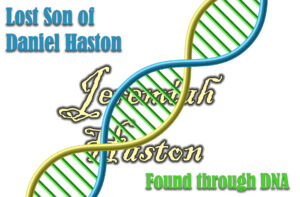
49 – Jeremiah Haston – A “Lost Son” of Daniel Haston Found by DNA
49 – Jeremiah Haston – Lost Son of Daniel Haston Found by DNA Sometimes you may see his name as Jeremiah MC Haston, but there
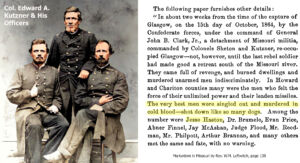
48 – Jesse Haston – His Family’s Civil War Years and Following
48 – Jesse Haston’s Family in the Civil War Years and After Some Selected Highlights Some of Daniel Haston’s grandsons and great grandsons joined the
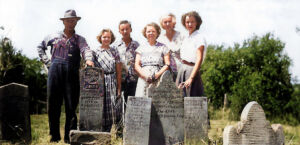
47 – Jesse Haston – A Missouri Pioneer with His Three Wives and 21 Children!
47 – Jesse Haston, Missouri Pioneer With 3 Wives & 21 Children Part 1 – Until the Civil War Of Daniel Haston’s sons, Jesse was

46 – Isaac Haston – Across the Plains in an Oxen-Drawn Wagon – Isaac’s California Years
46 – Isaac Haston – Across the Plains in an Oxen-Drawn Wagon The California Years Approximately 2,000 miles – Cave Spring, Missouri to Santa Rosa,
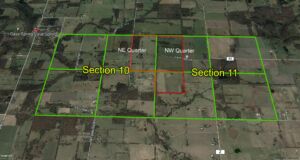
45 – Isaac and Agnes Simpson Haston – Missouri Years
45 – Isaac and Agnes Simpson Haston – Missouri Years Isaac Haston lived the Great American Dream. He left Tennessee landless and broke, moved to
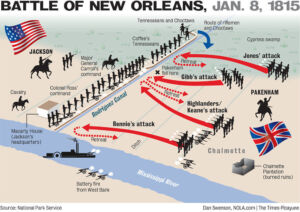
44 – Isaac and Agnes Simpson Haston – Tennessee Years
44 – Isaac Haston – Battle of New Orleans Hero & Much More Part 1 – His Tennessee Years Look at the battle map above.Â
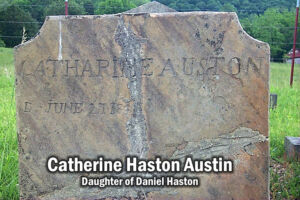
43 – John and Catherine HASTON Austin
42 – John and Catherine HASTON Austin History, especially genealogical history, is sexist!  OK, I’m pretty much a traditional-minded person and don’t use the word
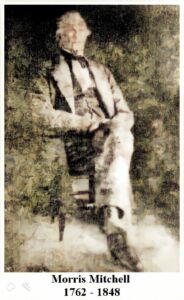
42 – Jacob and Lucinda Haston Mitchell
42 – Jacob and Lucinda Haston Mitchell Lucinda Haston – Daughter of Daniel Haston Jacob Mitchell was the son of Morris and Elizabeth Husong Mitchell

41 – Joseph Haston – Son of Daniel Haston
Joseph Haston – 2nd Son of Daniel Joseph and David were probably the only two sons of Daniel who were born in Virginia. If we

40 – Herbert Clinton Haston – Grandson of Montgomery Greenville Haston
40 – Herbert Clinton Haston, Grandson of Montgomery G. Haston The 1880 census record for D.L. (David Levander) and Virginia Riddles Haston A three-year-old boy,

39 – Montgomery G. Haston – His Civic Service and Civil War Experience
39 – M. G. Haston – His Civic Service and Civil War Experience Montgomery Greenville Haston is one of my most respected early Haston heroes!Â

38 – Mystery of the Father of Montgomery Greenville Haston
38 – Mystery of the Father of Montgomery Greenville Haston Based on the evidence cited previously, I think we can confidently assume Polly Haston was

37 – Mystery of the Mother of Montgomery Greenville Haston
37 – Mystery of the Mother of Montgomery Greenville Haston As far as we can tell, the parents of Montgomery Greenville Haston–and how he fit
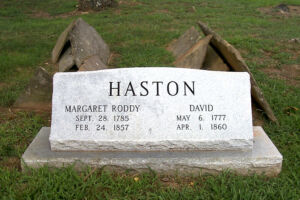
36 – David Haston – A Founding Leader in Van Buren County, TN
36 – David Haston – A Founding Leader of Van Buren County, TN David Haston spent much of his time in the final 20 years
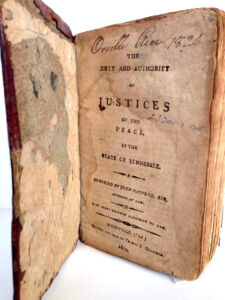
35 – David Haston, Popular Civic Leader in Early White County, TN
35 – David Haston – White County, Tennessee Pioneer, Part 2 David Haston, Esq. (Justice of the Peace) How did simple farmers and businessmen –
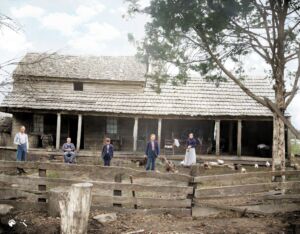
34 – David Haston (Daniel’s Son) in White County, TN
34 – David Haston, White County, Tennessee Pioneer, Part 1 Isaac T. Haston Family Home – Grandson of Daniel Via. David The “David Haston” Bible
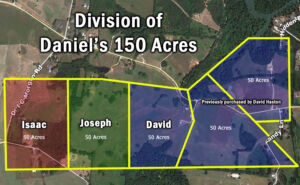
33 – Daniel Haston’s Final Years
33 – Daniel Haston’s Final Years Daniel Haston lived his final years on his 150 acres farm in what we now know as the Cummingsville
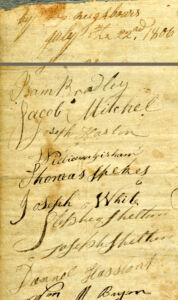
32 – Daniel Haston – Petitioner to Create White County, TN
32 – Daniel Haston, A Founding Petitioner for White County, TN The first record we have of Daniel Haston in (what became)Â White County, as well
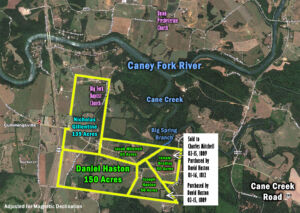
31 – Daniel Haston and the White County, TN “Big Spring” Settlers
31 – Daniel Haston & Other White County, TN Big Spring Settlers The area south of the Caney Fork River near the mouth of Cane
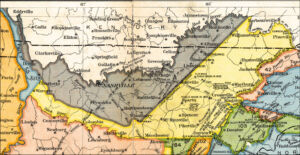
30 – Daniel Haston Family Moves Across the Cumberland Plateau
30 – Our Hastons Moved West of the Cumberland Mountain Through the Tellico Treaties of October 25 and 27, 1805, Cherokee chiefs ceded to the
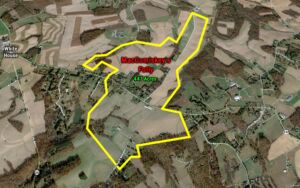
29 – Resolving the “McComisky Mystery” in the Daniel Haston Family
29 – Resolving the “McComisky Mystery” in the Haston Family A common piece of erroneous family lore has circulated among Daniel Haston family members for
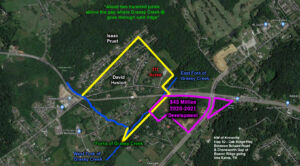
28 – David and Peggy Haston on Grassy Creek in Knox County, TN
28 – David Haston – Distinguishes Himself as a Young Adult Adjacent to a 2020 $45 Million Development Project At age 25, David Haston became

27 – David Haston Marries 14-Year-Old Girl
27 – David Haston Married 14 Year Old “Peggy” Roddy Yeah, I just created the title for the dramatic effect, but it was true. On May
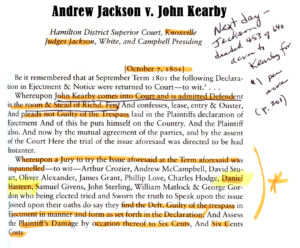
26 – Daniel Haston’s Many Experiences in the Knox County, TN Courtroom
26 – Daniel Haston’s Many Experiences in the Courtroom While Living in Knox County, TN When Daniel was a young man back in Shenandoah County,
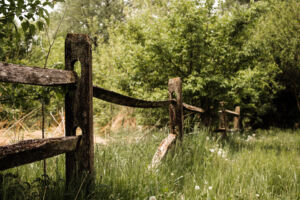
25 – Another Haston Boy in Trouble – Joseph and the Broken-Down Fence
25 – Another of Daniel Haston’s Boys in Trouble Joseph and the Broken-Down Fence Let’s start with a couple of definitions, for those of you

24 – Daniel’s Son David Haston Cut Tails Off a Neighbor’s Cows
24 – David Haston Cut Tails Off a Neighbor’s Horned Cows Some of us Haston boys have been known for mischief. Just ask people who

23 – Daniel Haston Family – South of Holston River, Opposite Knoxville, TN
23 – Daniel Haston Family, South of the “Holston” River Opposite Knoxville, TN Daniel and family lived in the Knoxville, TN area for about 10

22- Two of Daniel Haston’s Siblings in South Central KY
Two of Daniel Haston’s Siblings in South Central, KY The Mill Creek Meeting House Near Tompkinsville, KY. Built in 1804. Abraham Hiestand’s (Hestand’s) Path Ends
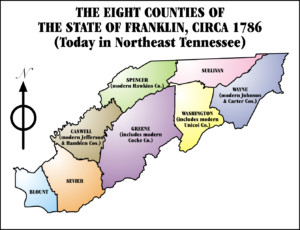
21 – Daniel Haston Votes in Favor of the State of Franklin
21 – Daniel Haston Voted in Favor of the State of Franklin So, our Daniel was a “Franklinite” The yellow county – Washington County –
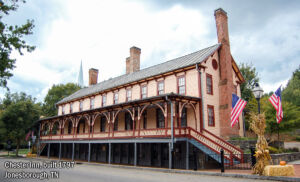
20 – Abraham and Daniel Hiestand in the “Overmountain” Wilderness of NC
20 – Abraham and Daniel in the “Overmountain” of NC For approximately 10 to 15 years, Henry Hiestand’s “boys”–Daniel and his older brother Abraham–lived in
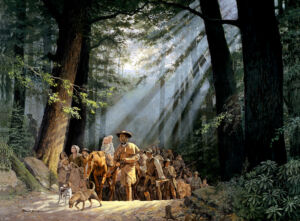
19 – The Hiestand Brothers – Abraham and Daniel – Settle in Western North Carolina
19 – Abraham and Daniel Hiestand Settle in the “Carolinas” Headed for “the Carolinas” When the earliest post-Revolution settlers left their homes in places like
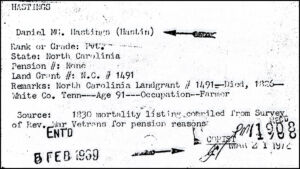
18 – The Mysterious Daniel MG Hastings “Mortality List” Card
18 – The Mysterious Daniel MG. Hastings Mortality List Card The “1830 Revolutionary War Mortality Listing” Card In the early 1970s, Dwight Haston discovered the
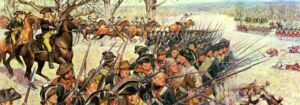
17b – Thomas Archer – the Eccentric Man from Guilford County, NC Who Ended Up with Warrant #2344
Thomas Archer – an Eccentric Man from Guilford County, NC Who Ended Up With 640 Acres from Military Bounty Land Warrant #2344 This is #3
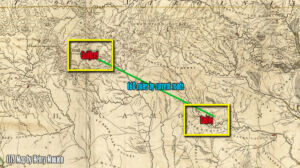
17a – The “Guilford County Four” and Rev War Land Grant Proceedings at Fairfield Plantation
17a – The “Guilford County Four” And the Epicenter of 1785 Land Fraud – James Glasgow’s “Fairfield” Plantation This is #2 in a sequence of
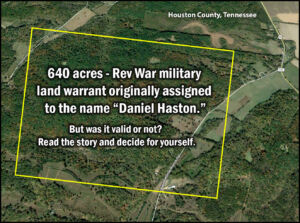
17 – The “Daniel Haston” Revolutionary War Land Grant
The “Daniel Haston” Rev War Land Grant Legal or Fraudulent? 640 acres in Houston County, TN (west of Nashville) were granted to Thomas Archer, based

16 – Daniel Haston and the DAR and SAR
16 – Can I Get Into the DAR or SAR through Daniel Haston? The centennial of the signing of the Declaration of Independence in 1876
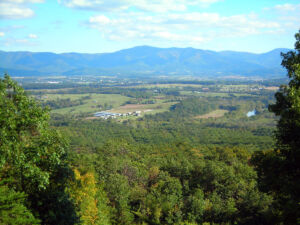
15 – Henry Hiestand’s Estate Settled and the Family Splits
15 – Henry Hiestand’s Estate Settled and the Family Parts Ways Daniel’s Mother & Father Die in 1777 and 1779 Peter Hiessandt, Sr.’s, (older brother
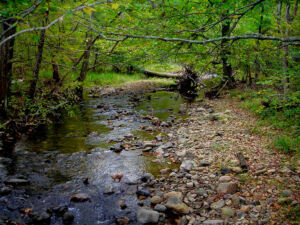
14 – Daniel & Christina Nave Haston – Newlyweds in Fort Valley
14 – Daniel & Christina Nave Hiestand/Haston Newlyweds in Fort Valley, VA Daniel and Christina lived on Passage Creek for the first ten years or

13 – Daniel Hiestand Married Christina Nave
13 – Our Daniel Hiestand Married Christina Nave In Shenandoah County, Virginia View Larger Version of this Image I think we can safely say it’s

12 – Hiestand Land in “The Fort” – Powell’s Fort Valley, VA
12 – Hiestand Land in “The Fort” – Fort Valley, Virginia Seven Bends of North Shenandoah River, near Woodstock, VA with Fort Valley in the
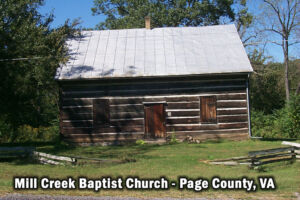
11 – The Henry Hiestand Family in Virginia
11 – The Henry Hiestand Family in Virginia When Henry Hiestand and his wife (name unknown) moved their family to Virginia, they probably already had
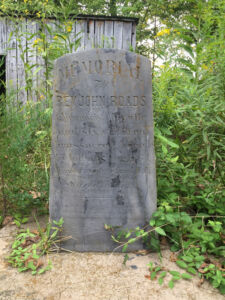
10 – Indian Troubles in the Shenandoah Valley, VA
10 – Indian Attacks Around Our Hiestands in Pennsylvania and Virginia Memorial for Rev. John Roads – Mennonist & wife and six children massacred here
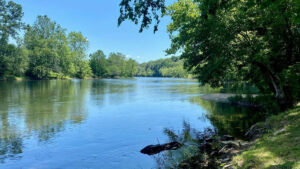
09 – Our Ancestor Moves to the Shenandoah Valley, VA
Hiestands Move to the Shenandoah Valley in Northern Virginia From a “Hiestand field” on the South Fork of the Shenandoah River Our Daniel Hiestand/Haston was
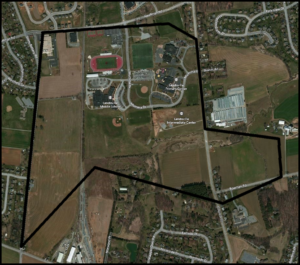
08 – Henry Hiestand Settles on Penn Family Land
08 – Henry Hiestand Settled on Land Acquired from William Penn’s Sons Outline of the 226 acre tract Henry Hiestand settled on and had surveyed

07 – Our Hiestands Begin Life in America
07 – Henry Hiestand – His Earliest Years in America William Penn’s first visit to his American colony in 1682 paved the way for our
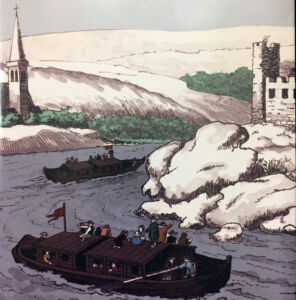
06 – The Journey from Ibersheim to America
06 – The Journey from Ibersheim to America Source: http://olivetreegenealogy.blogspot.com/ In early 1727, Henrich Hiestand probably boarded a barge in Worms, much like the one
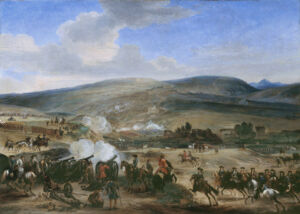
05a – Our Hiestands (Heystandts) – Refugees on the North Sea
05a – Our Hiestands (Heystandts) – Refugees in Friedrichstadt on the North Sea “Heystandt” was the way the Hollander-Dutch spelled our Hiestand name. The Nine
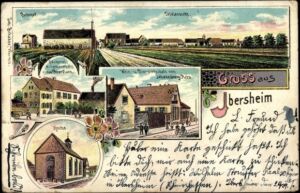
05 – Where Henrich Hiestand Was Born – Ibersheim, Germany
05 – Ibersheim, Germany German Home-Village of Our Hiestands https://www.akpool.de/ The village of Ibersheim (pronounced, Ibers-heim [“ib” as in “crib”]) is situated on what historically
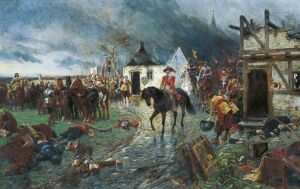
04 – Swiss Anabaptists Flee to the Germany
04 – Our Swiss Ancestors Flee to Germany (Source: artuk.org) The Thirty Years War (1618-1648) Paves the Way for Swiss Anabaptists to Find New Homes

03 – Our Mennonite Roots
03 – What Do You Know About Our Mennonite Roots? Image from Christianity.com Rev. Samuel Hiestand’s parents, grandparents, and several generations before were all Mennonites.
If you appreciated this article, please share it with others who might also enjoy it.




